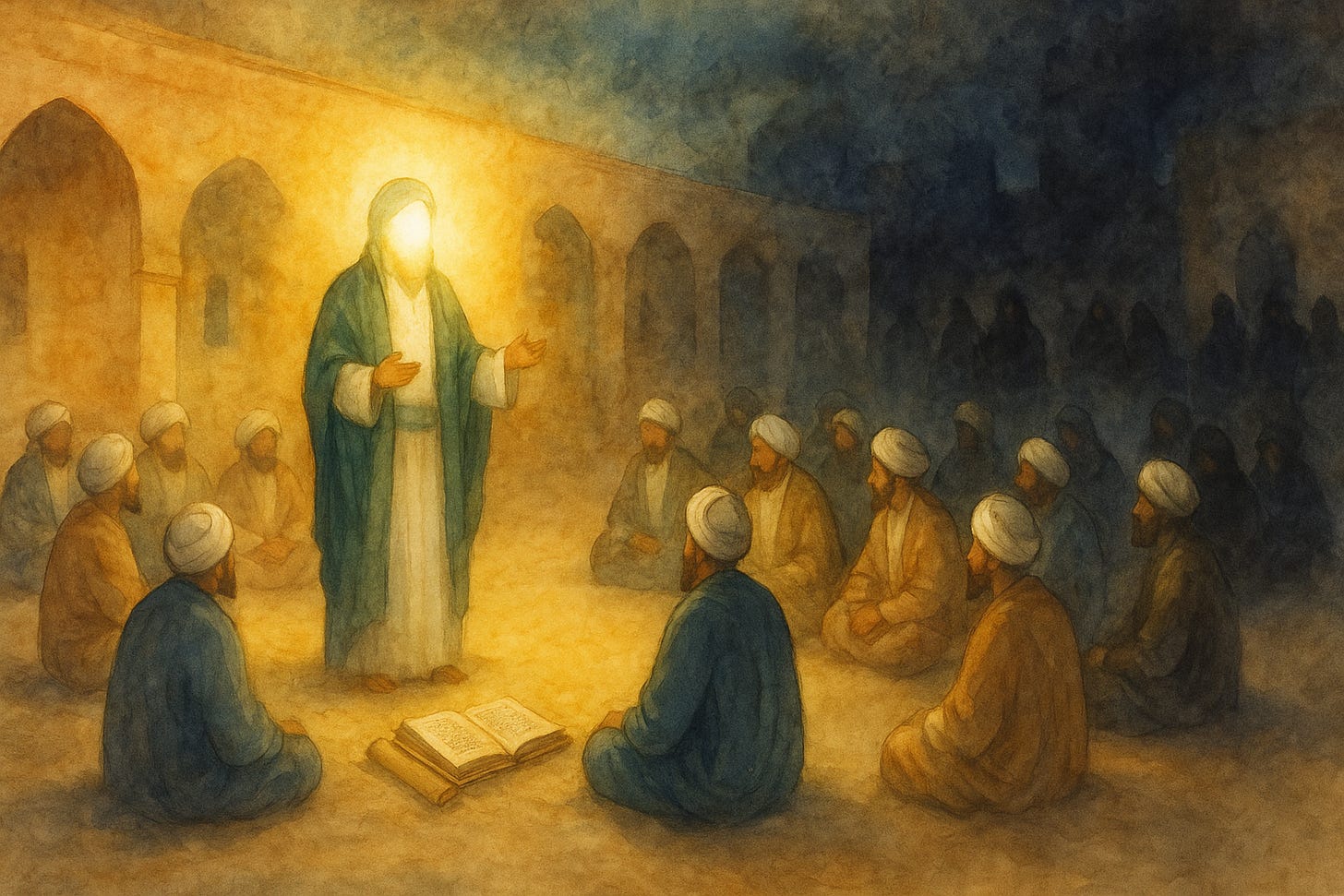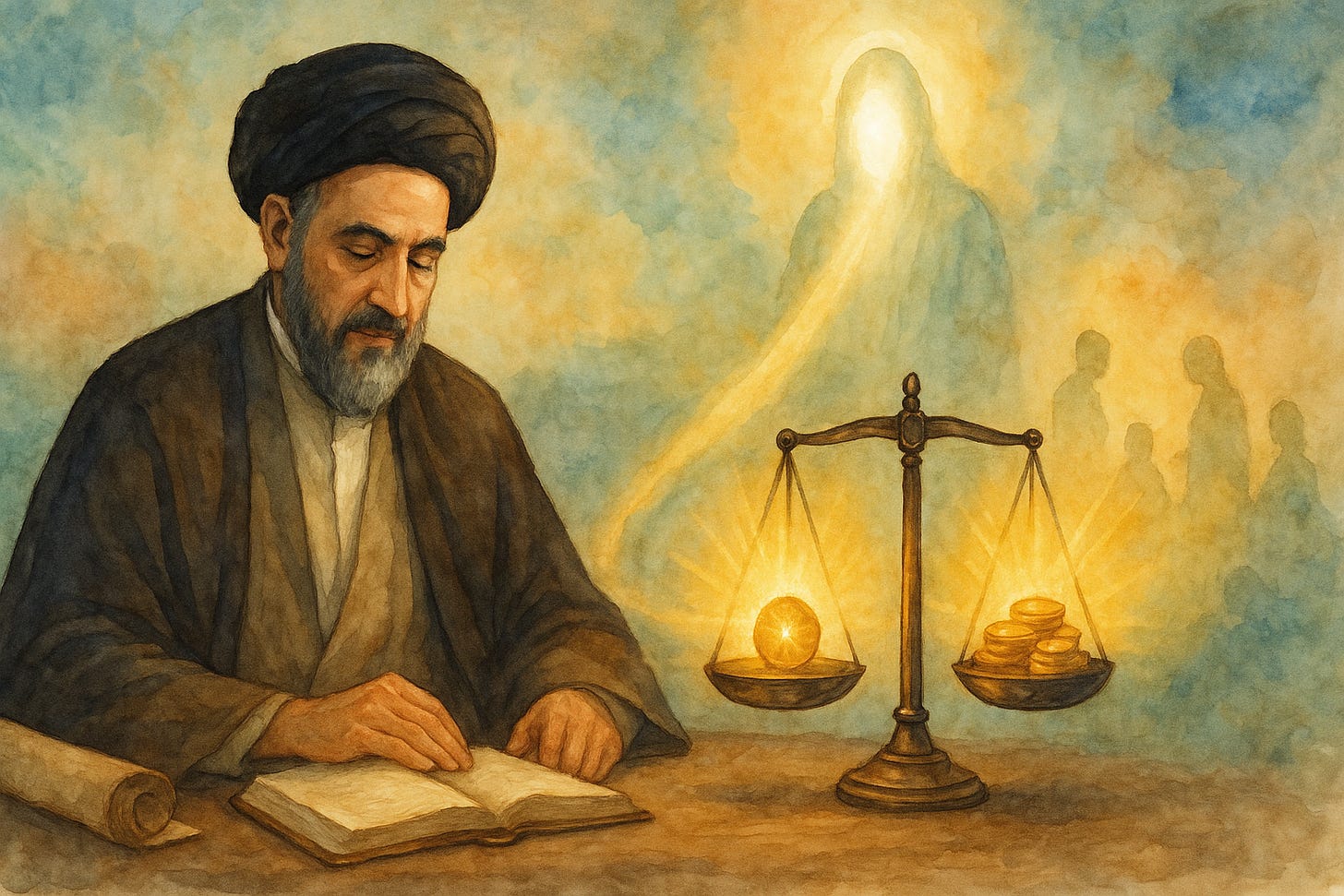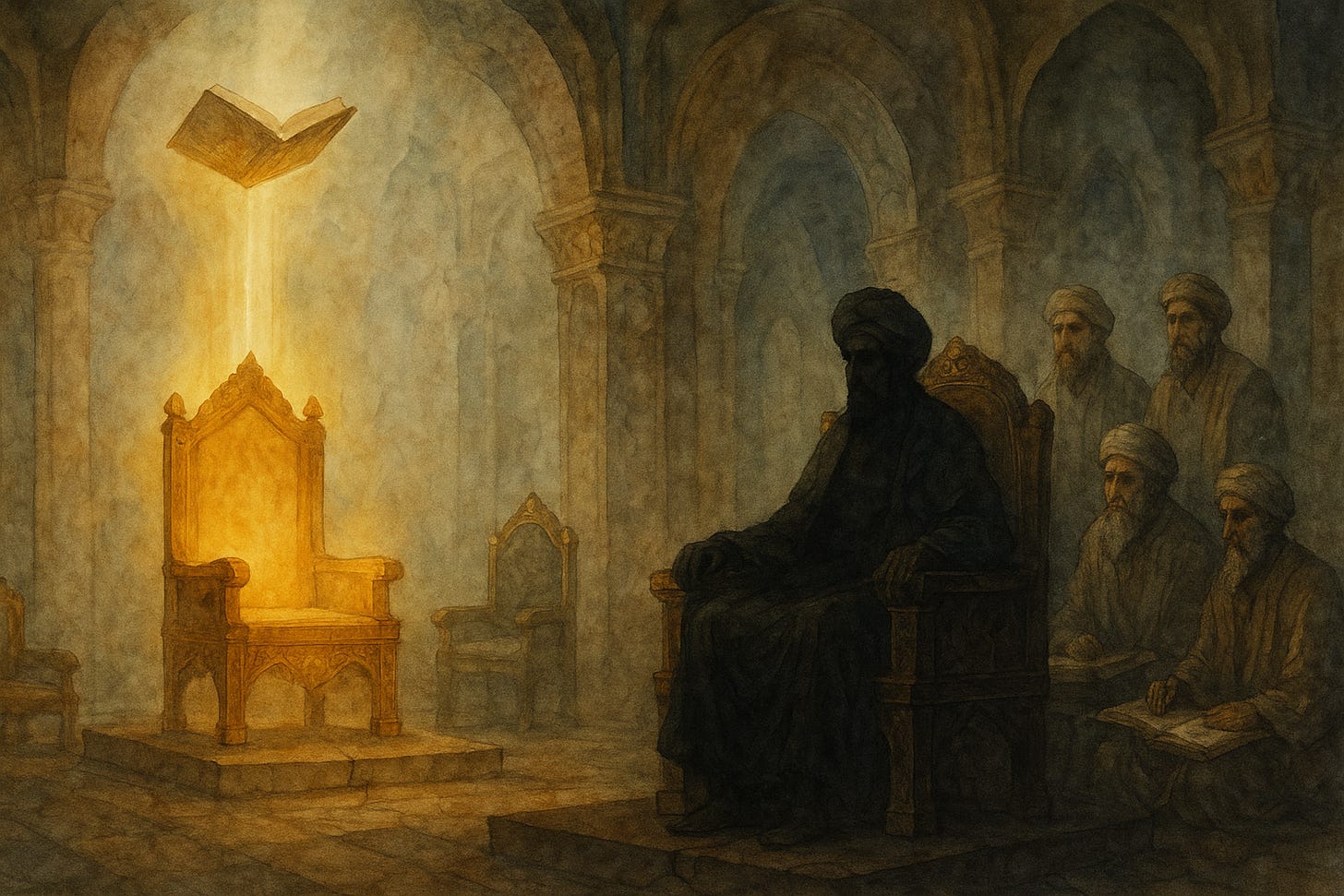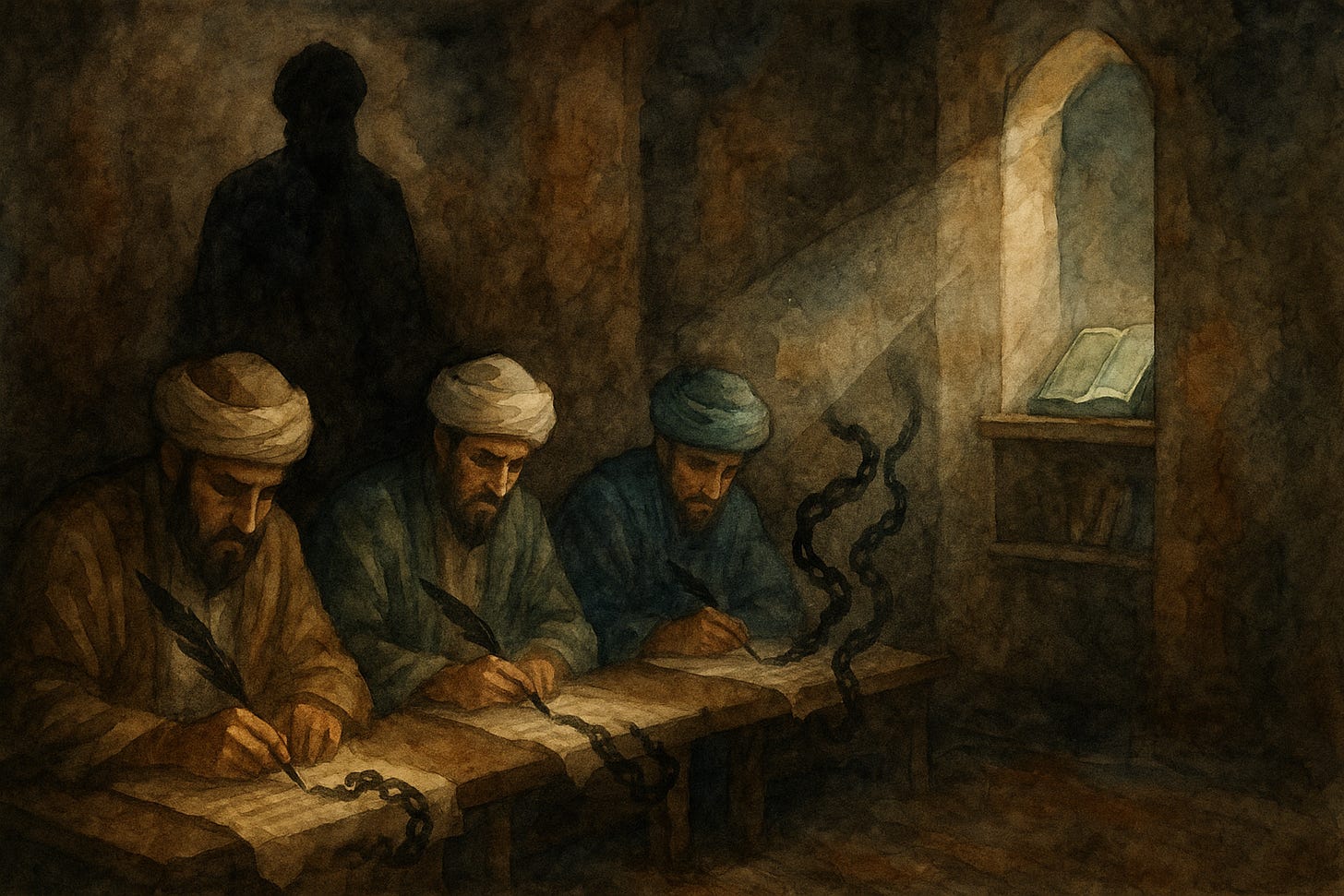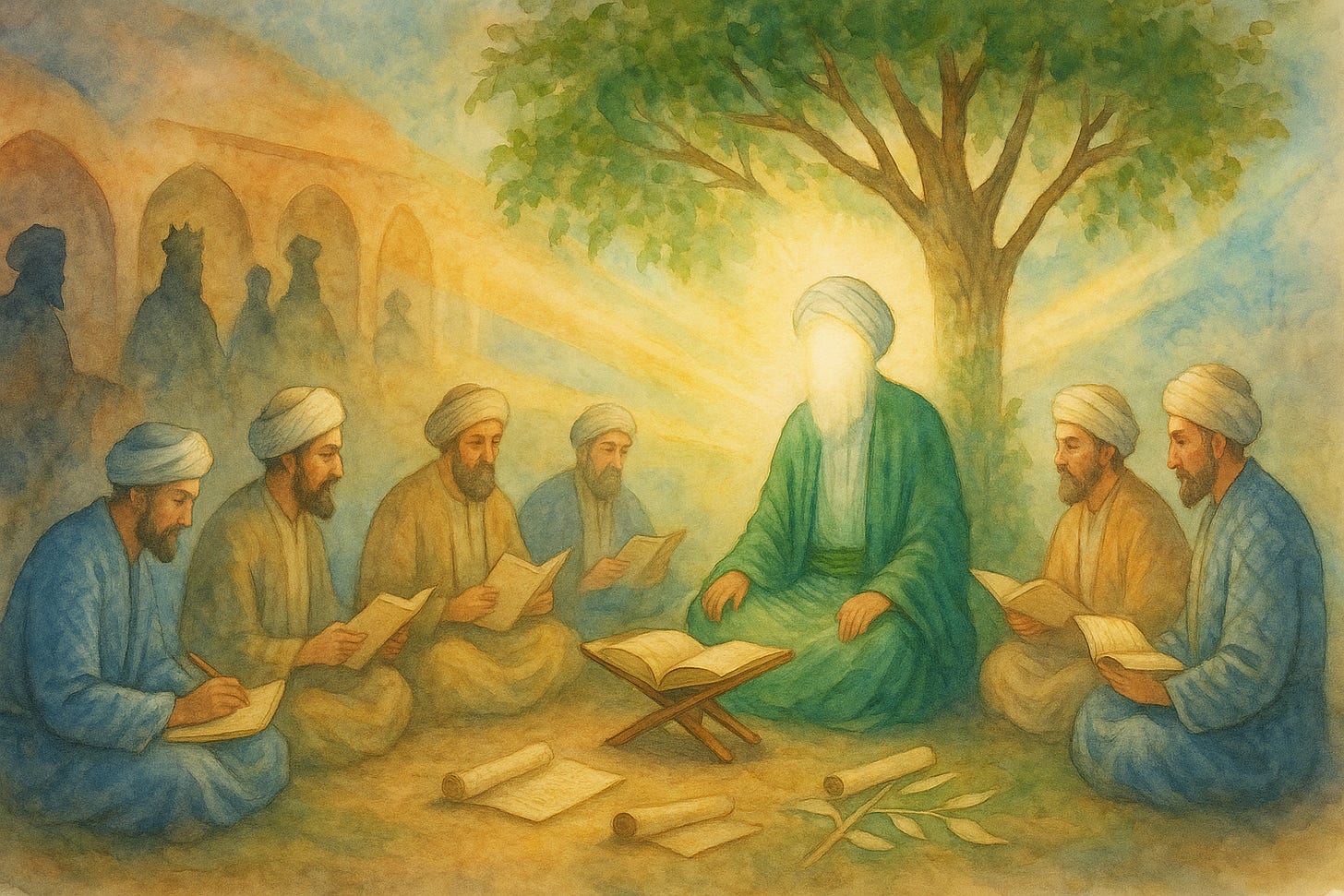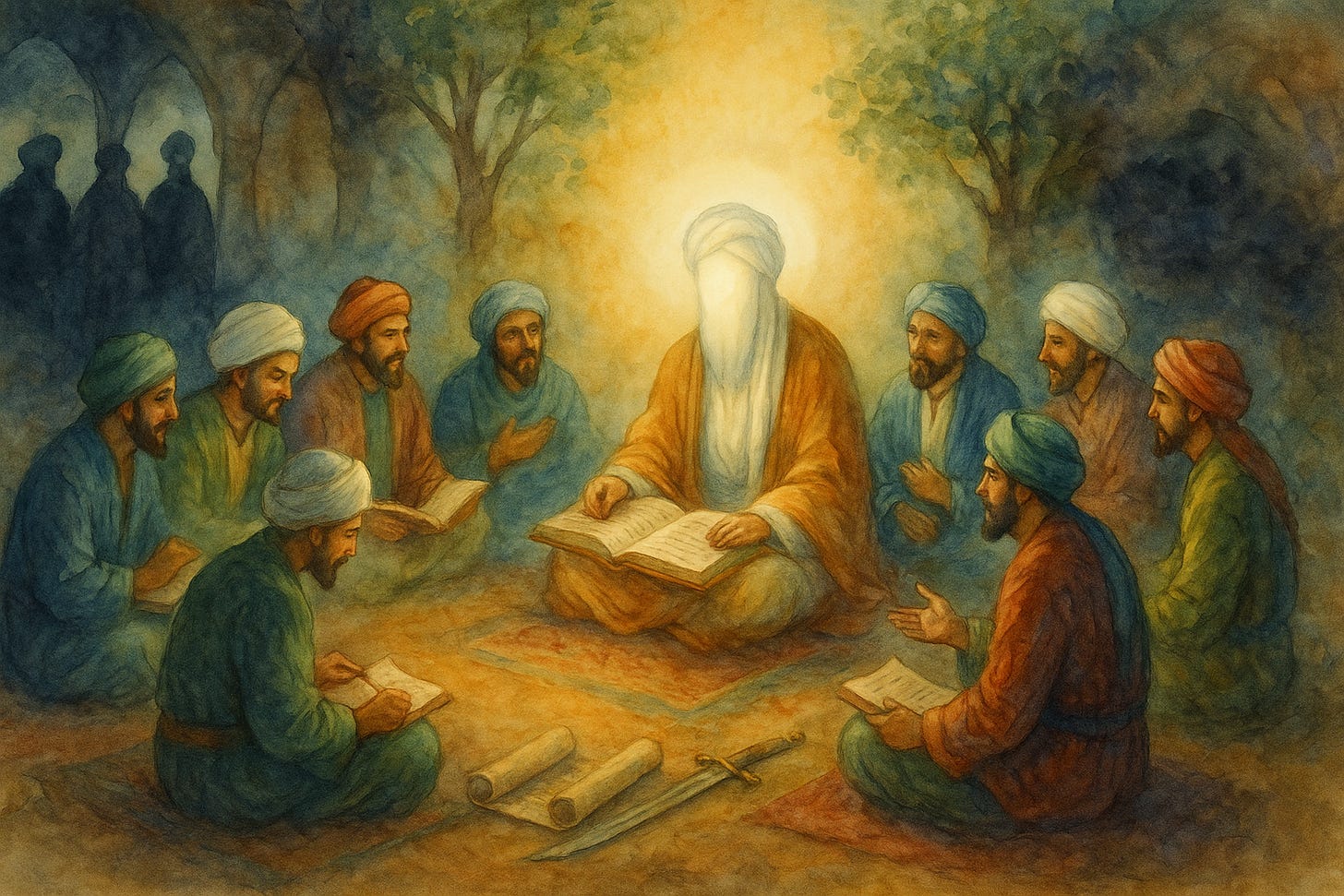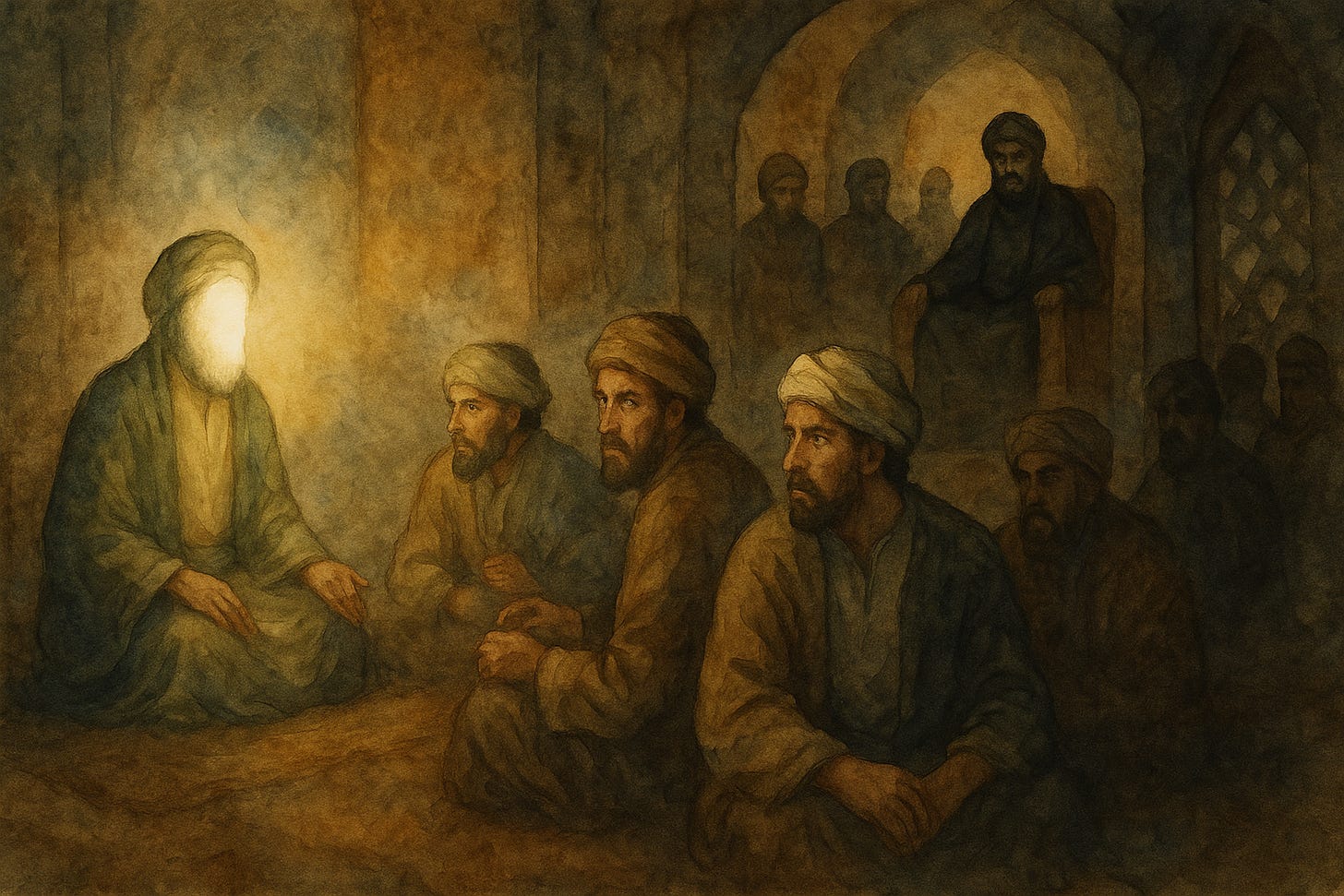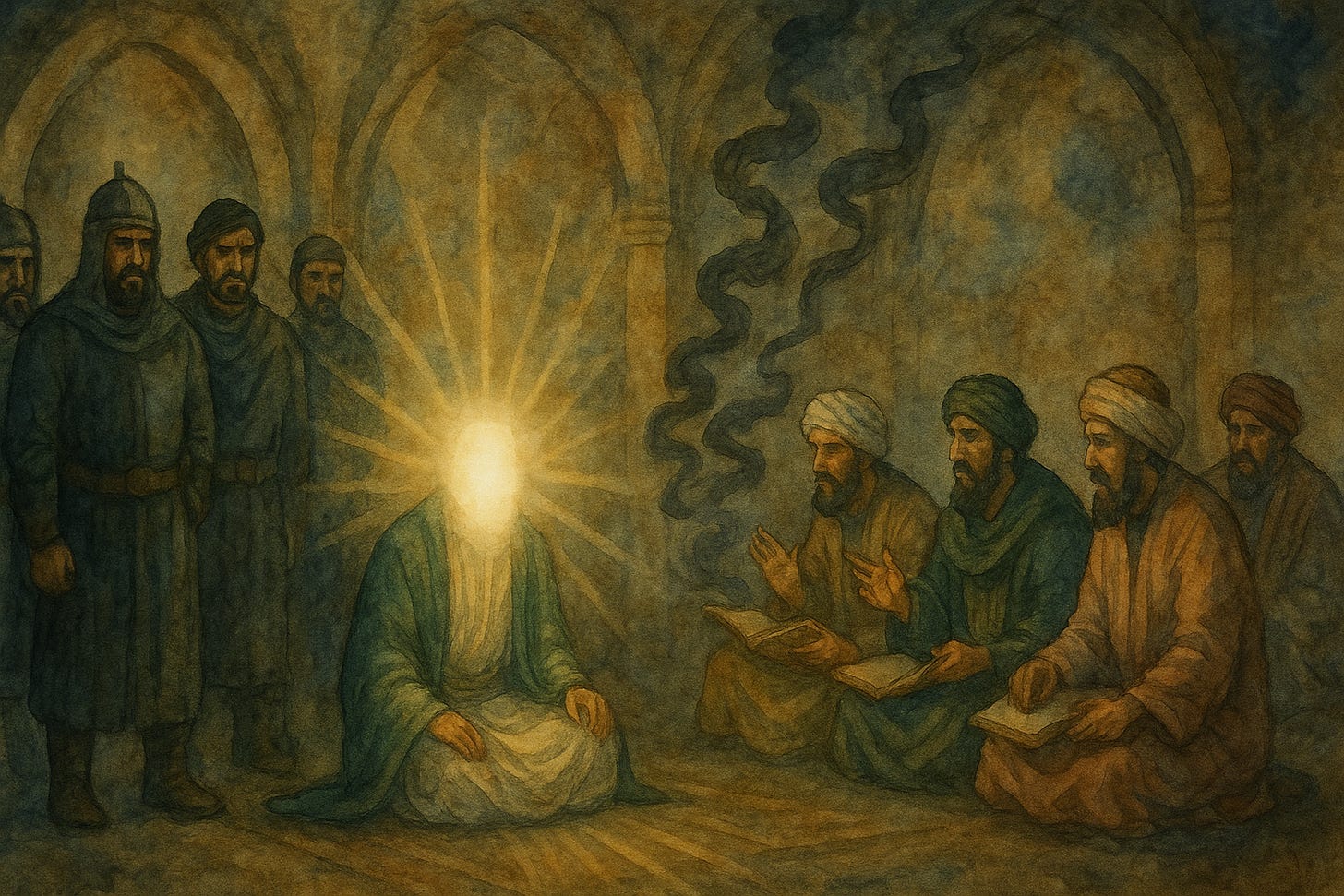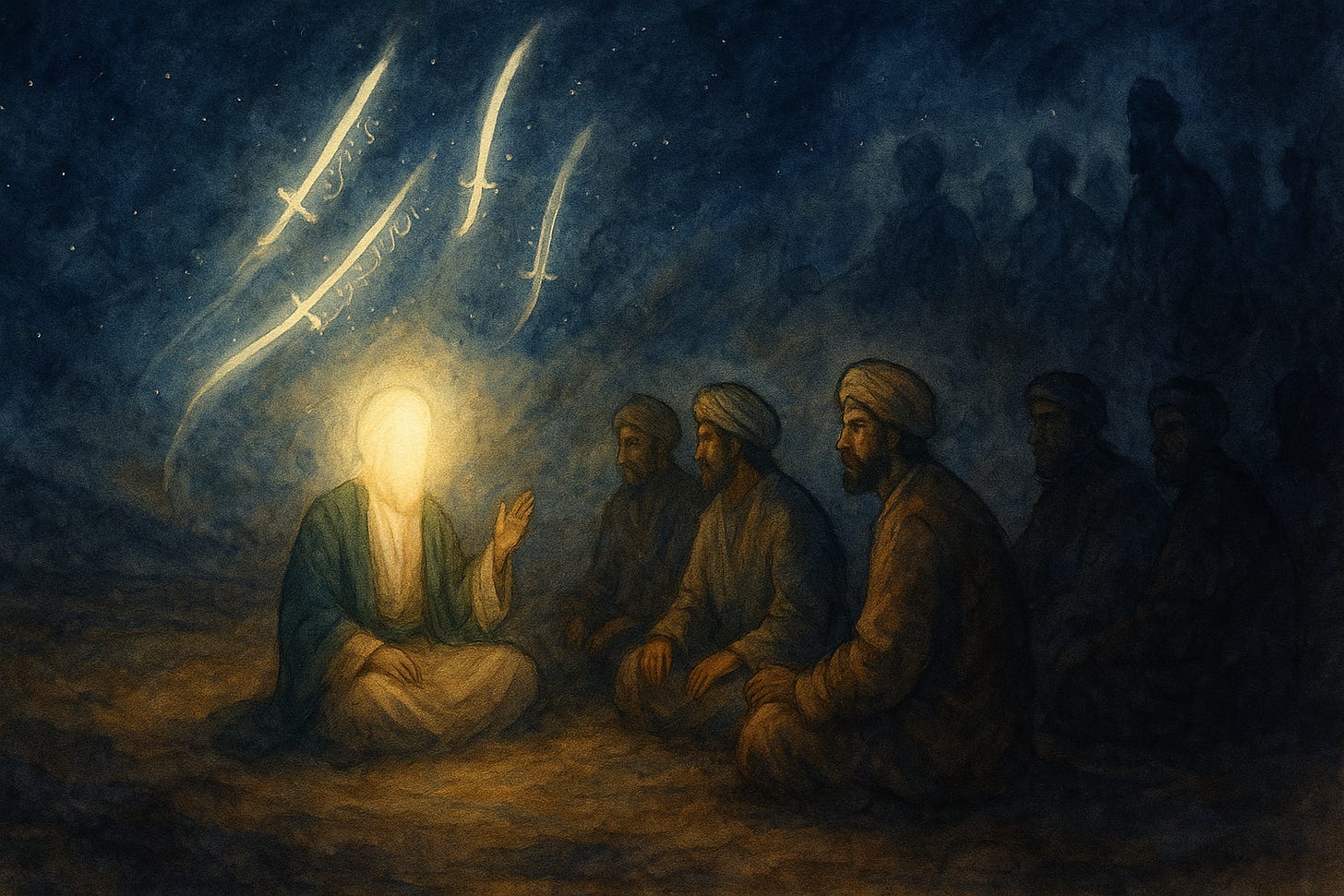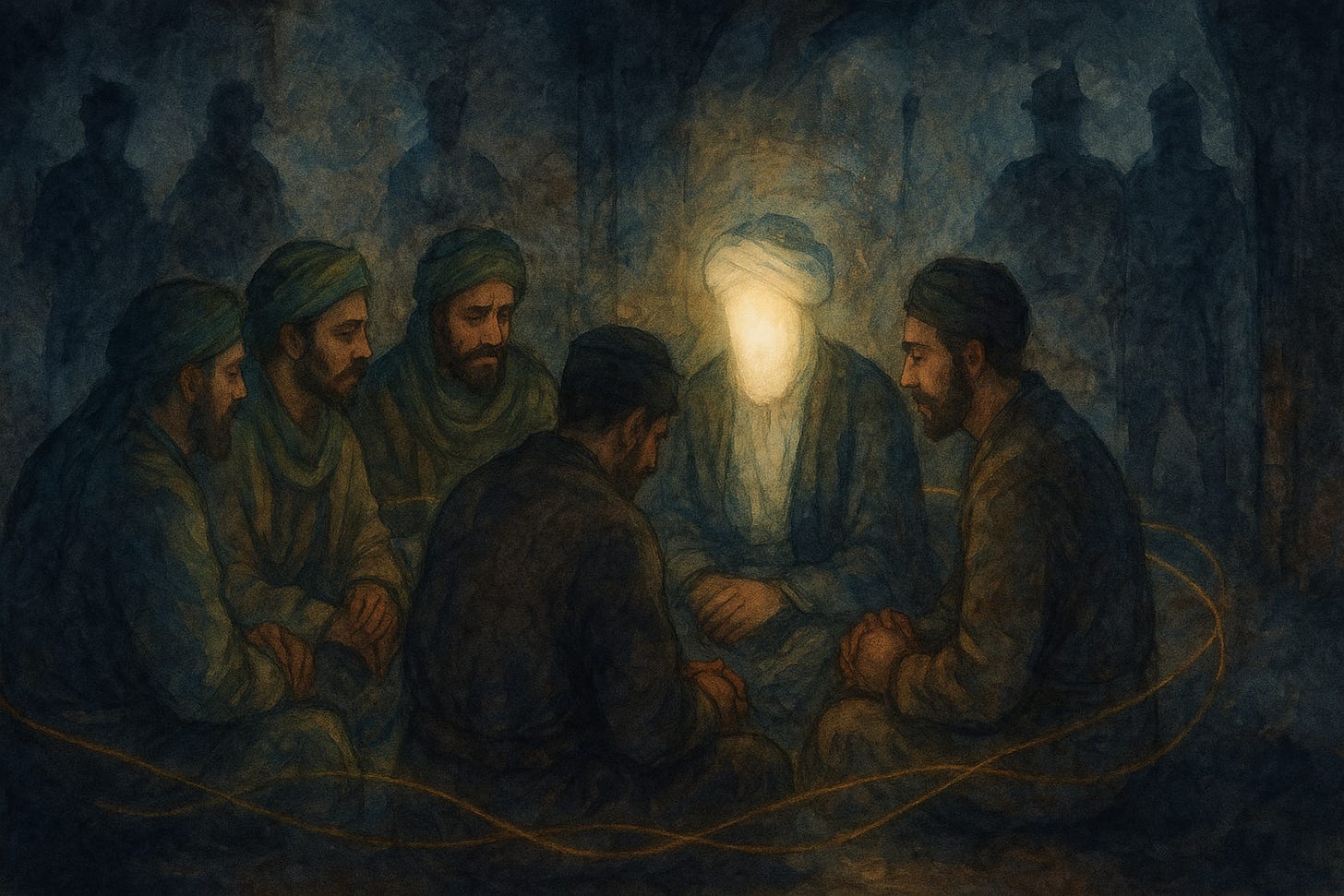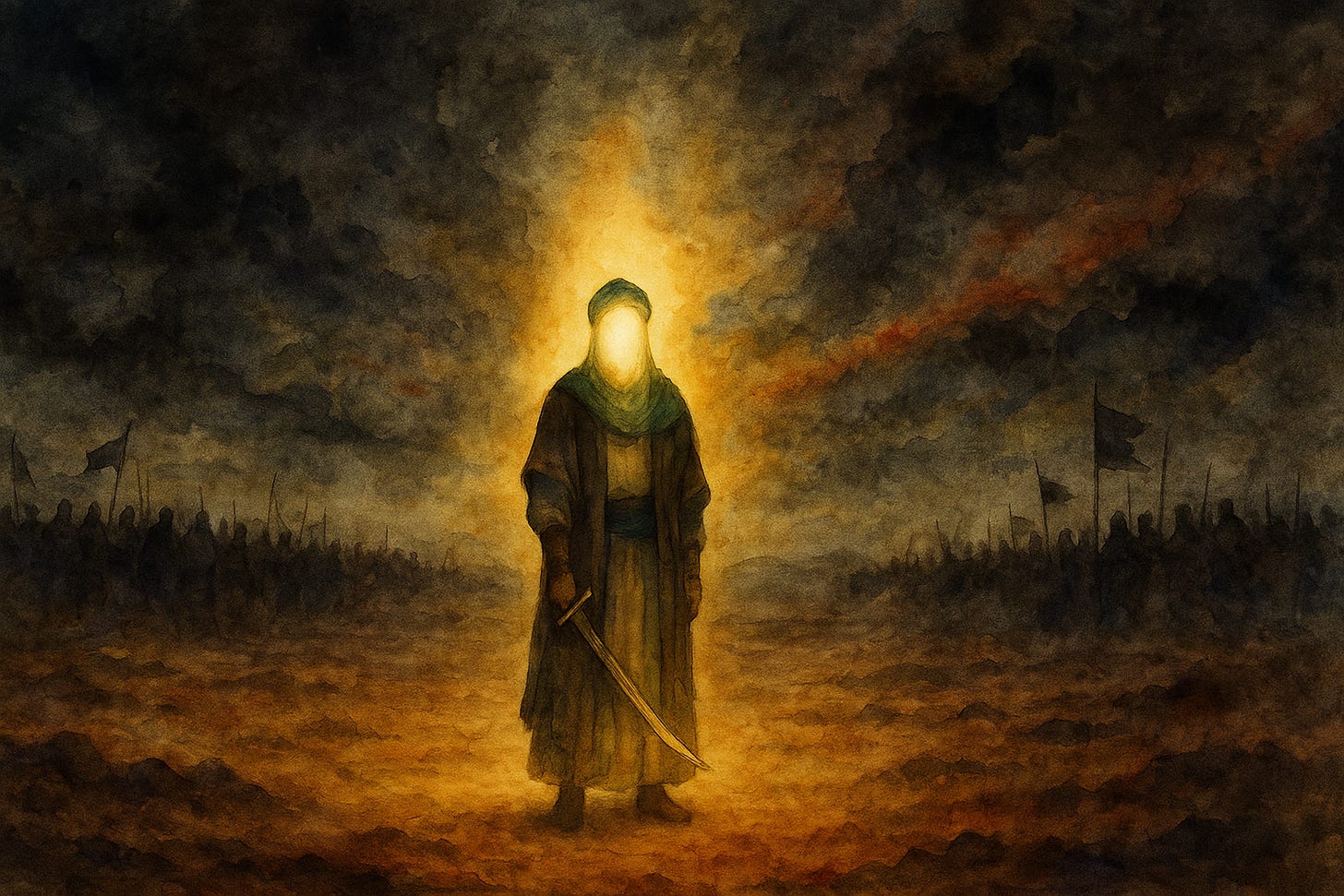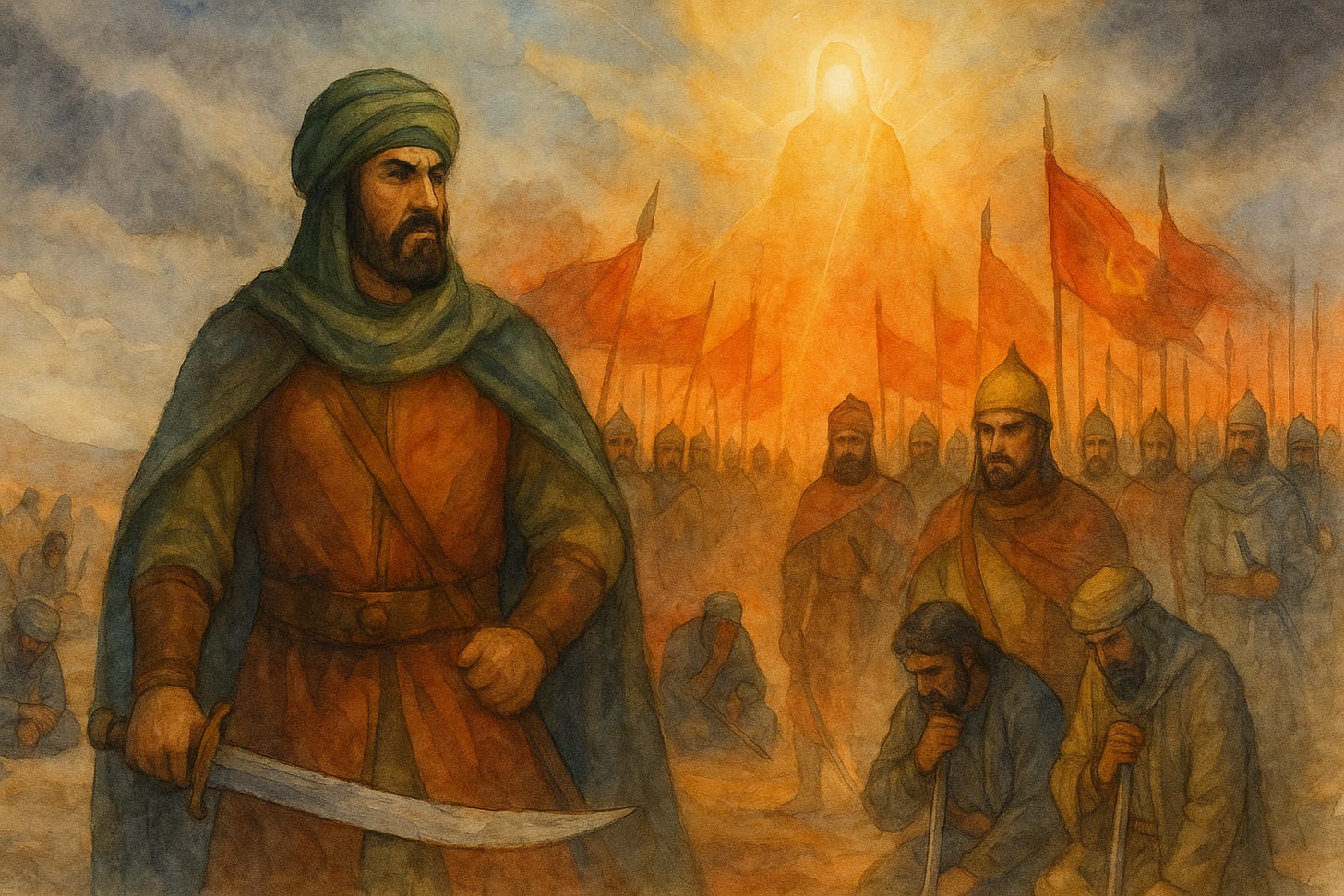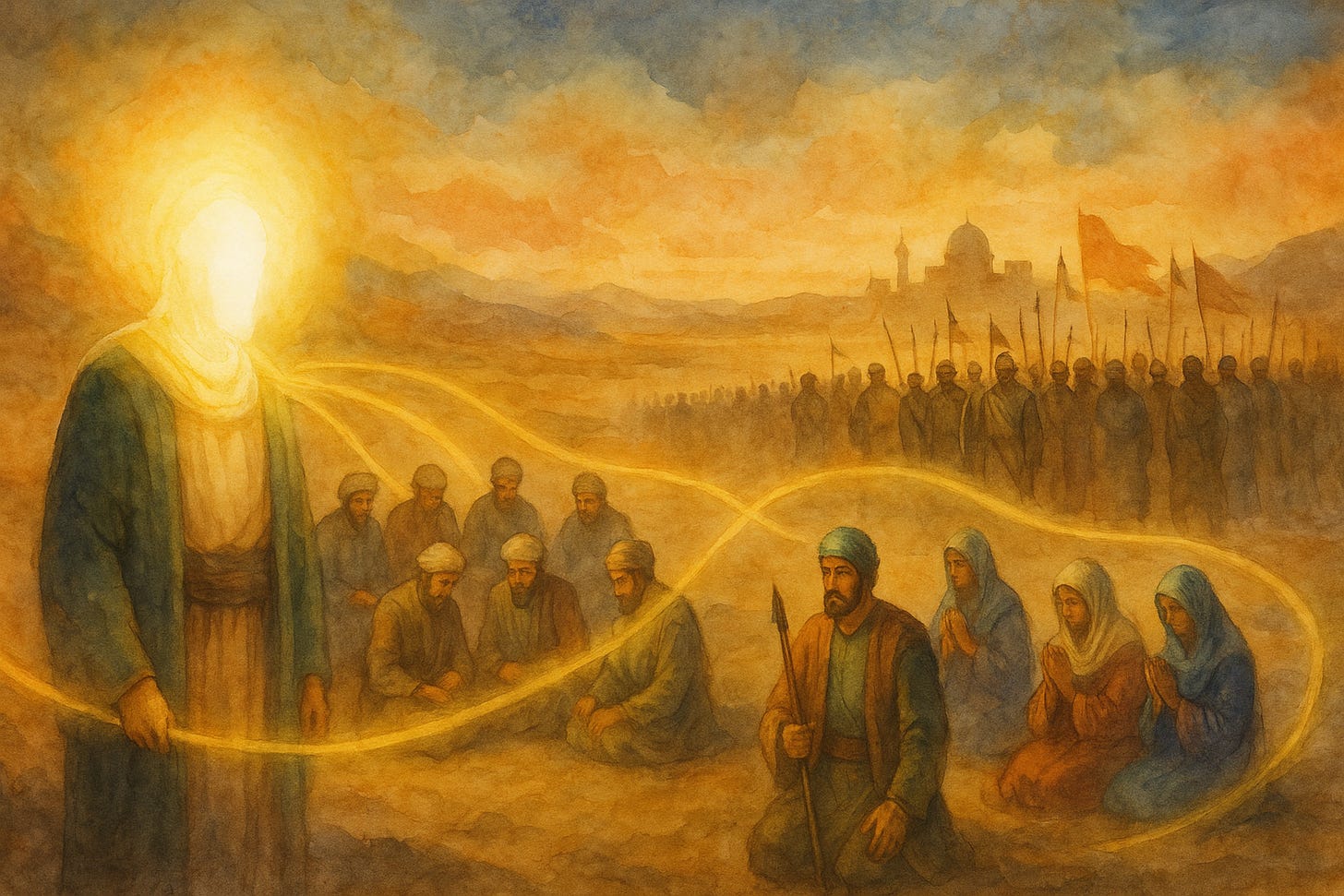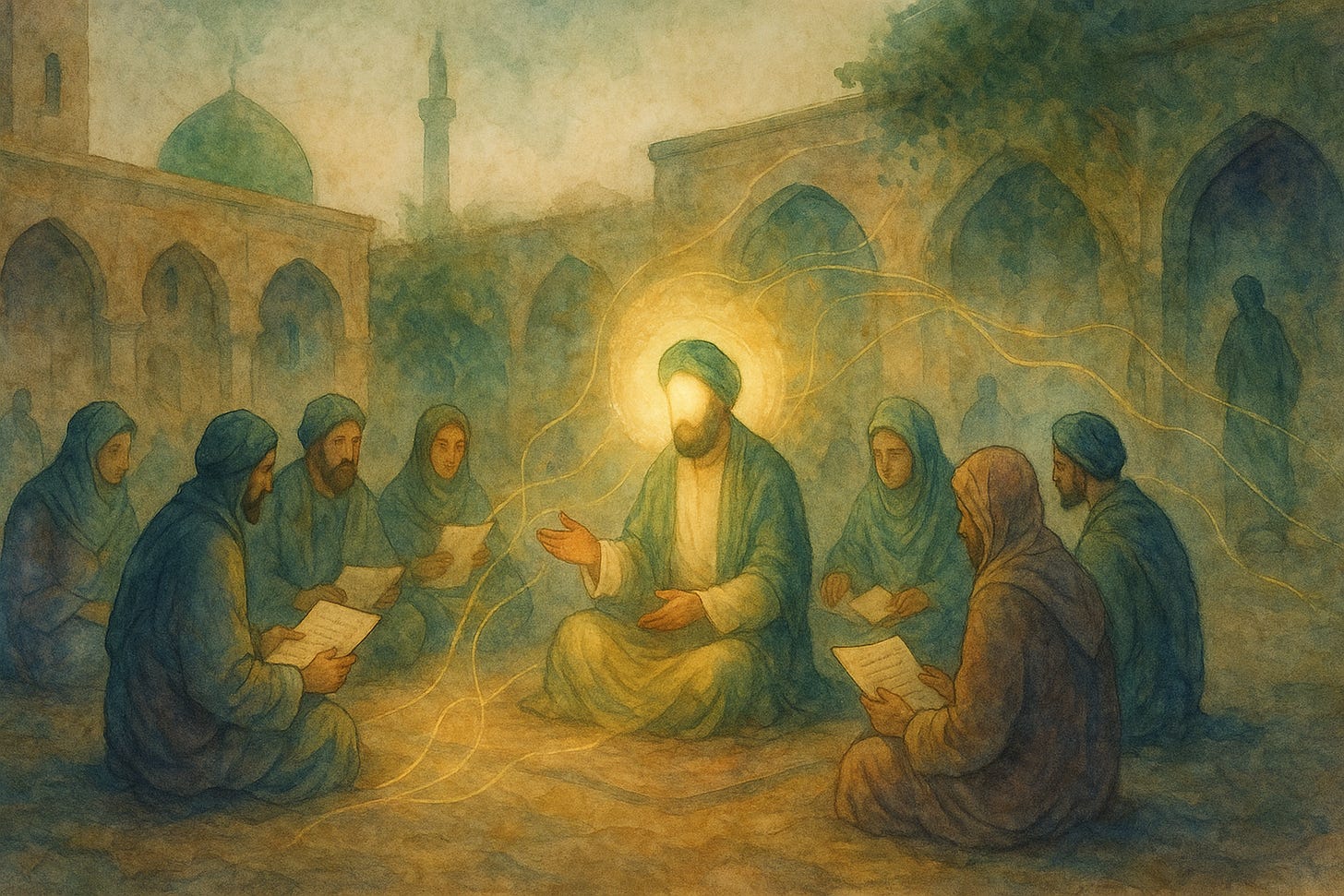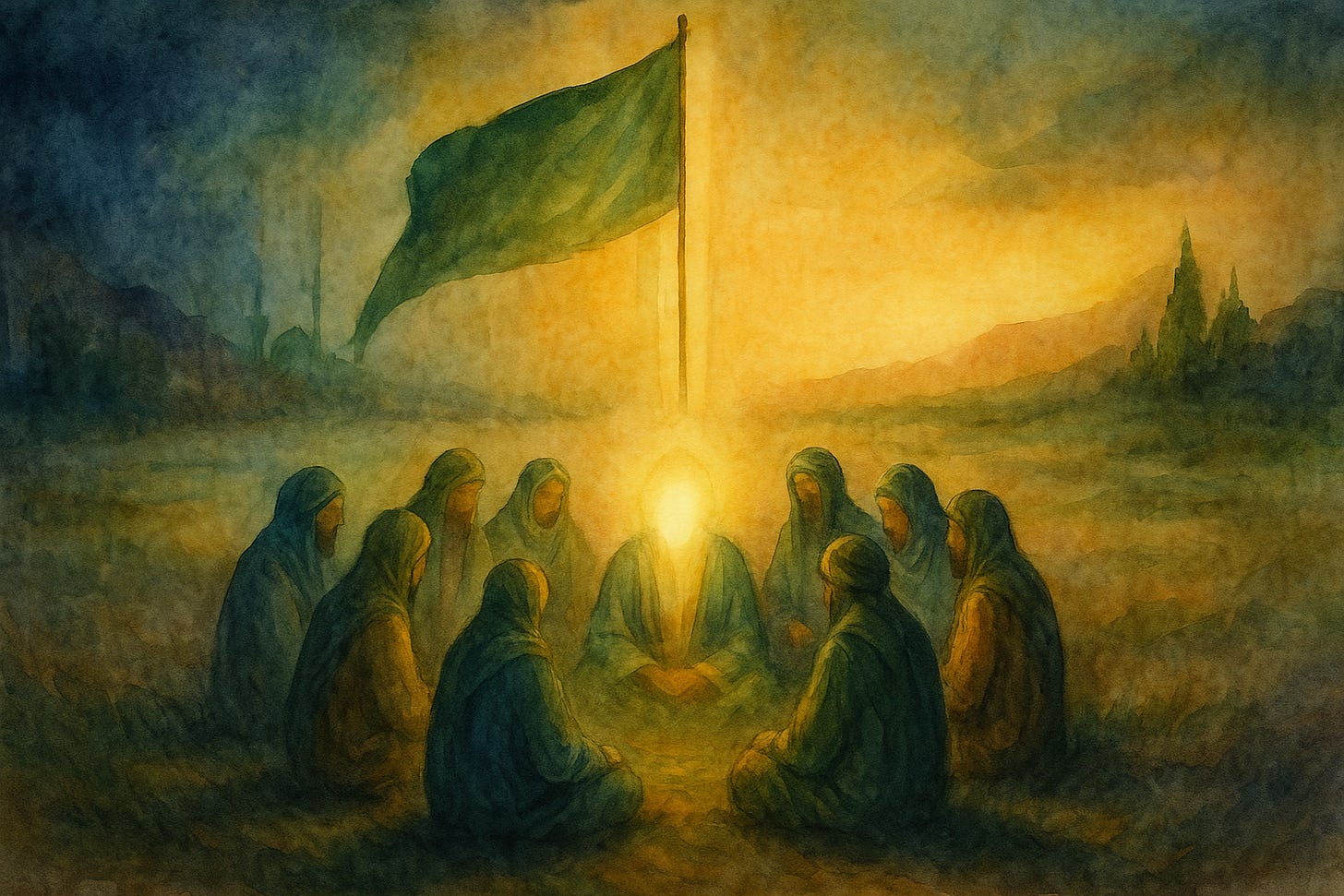[31] Imamah (Leadership) - Imam al-Sadiq: The Sword of Knowledge and the Shield of Prudence
A series of discussions on the teachings of Imam Sadiq (sixth Imam of the Muslims), from the book Misbah ash-Sharia (The Lantern of the Path)
In His Name, the Most High
This is part thirty-one of an ongoing series of discussions on the book attributed to Imam al-Sadiq entitled ‘Misbah ash-Sharia’ (the Lantern of the Path).
As is the case for each of the sessions in this series (and previous series), there is a requirement for the reader to at the very least take a cursory look at the previous sessions - though studying them properly is more beneficial - as the nature of this subject matter requires, a building up of understanding in a step by step manner.
Since each session builds on the one before, it is crucial that the previous sessions are studied - at least in a cursory manner, though fully is more beneficial - so we can try to ensure that misunderstandings and confusion do not ensue, as well as ensure we can garner more understanding from each session.
The previous parts can be found here:
Video of the Majlis (Sermon/Lecture)
This is the video presentation of this write-up as a Majlis (part of the Truth Promoters Weekly Wednesday Majlis Program)
Audio of the Majlis (Sermon/Lecture)
This is the audio presentation of this write-up as a Majlis (part of the Truth Promoters Weekly Wednesday Majlis Program)
Recap
Before we begin our journey into the life of the sixth Imam, it has been some time since we last gathered, a period during which the echoes of Ashura and the lessons of Arbaeen have settled in our hearts. It is only fitting, then, that we pause and retrace the path we have walked together in this series, The Lantern of the Path, for our journey is a single, unbroken chain of understanding.
We began not with abstract doctrines, but with the very essence of our existence: Ubudiyyah, or true Servitude to God. We learned that to be a true servant is to first understand the rights of the One we serve. This led us to the bedrock of our ideology, not as a list of disconnected beliefs, but as a holistic journey towards Him.
Our goal, we established, is Tawheed—to be entirely absorbed in the Uniqueness of our Beloved. The destination that proves our worthiness for that goal is Ma'ad, the Day of Judgment. The path between this beginning and that end is illuminated by the constant, unwavering principle of Adalah—the Justice of God.
Under the expansive canopy of His Justice, we explored its manifestations: Nubuwwah (Prophethood), the divine call to resurrect society from ignorance, Wilayah (Guardianship) and Imamah (Leadership), the guardianship that protects and clarifies this call through the ages.
We did not study these as mere history. We bore witness to them as a living, breathing reality, a continuous struggle against the forces of Taghut (Rebellion).
We followed this sacred light from the mission of the Seal of the Prophets, Prophet Muhammad (peace and blessings be upon him and his family), through the steadfastness of the Commander of the Faithful, Imam Ali (peace and blessings be upon him). We examined the oft-misunderstood pillar in the structure of divine guidance, Sayyedah Fatimah az-Zahra (peace and blessings be upon her). We saw the profound wisdom in the strategic patience of Imam Hasan, and felt the earth-shattering sacrifice of the Master of the Martyrs, Imam Husayn. We, then, walked in the footsteps of the Messengers of Karbala—the indomitable Sayyedah Zaynab and the resilient Imam Sajjad, whose whispered revolution of supplication kept the flame of truth alive in the darkest of nights.
And this brought us to our last session, where we turned the page from the tears of Imam Sajjad to the dawn of a new era. We did not simply learn about the fifth Imam; we encountered the architect of a grand renewal: Imam Muhammad ibn Ali al-Baqir, the Splitter of Knowledge.
We witnessed how his Imamate served as the pivotal bridge between the quiet endurance of his father and the great intellectual ocean that would be unleashed by his son.
In an era where the tyrants of the Umayyad dynasty had grown momentarily complacent, Imam al-Baqir seized the lull not with the sword, but with sacred knowledge.
He transformed the Prophet’s Mosque into a fortress of correct creed, refuting the distortions of palace scholars and reviving the revolutionary principle that every matter must be measured against the Book of God and the Sunnah of His Messenger. He laid the foundations, organised the network of true believers, and prepared the soil for the seeds of a profound intellectual awakening.
He was the one who split open the earth of a dormant Ummah to reveal the pure springs of Prophetic wisdom that lay beneath. And in doing so, he paved the way for the one who would inherit his mission and turn those springs into a flowing, unending river: his son, and our guide for the sessions to come, Imam Ja’far al-Sadiq.
And so, with our memories refreshed and our purpose renewed, we turn our gaze from the Splitter of Knowledge to the Ocean of Wisdom.
In His most beautiful Name, and filled with awe at His profound love for His creation, we continue…
Imamah (Leadership) - Imam al-Sadiq: The Sword of Knowledge and the Shield of Prudence
The Inherited Mission: From Whispered Revolution to a Planned Uprising
When the soul of Imam Muhammad al-Baqir (peace be upon him) ascended to its Lord, the landscape of the Islamic world was in flux. The whispered revolution of Imam Zayn al-Abedeen (peace be upon him), carried in his supplications and secret gatherings, had been nurtured by the careful, methodical wisdom of Imam al-Baqir.
The seeds were ready to break through the soil.
The Umayyad dynasty, rotting from within, was consumed by internal power struggles. Its weakness was a gaping wound, and the stench of its corruption filled the air.
Into this volatile world, Imam Ja‘far al-Sadiq (peace be upon him) inherited the mantle of Imamate — not merely as a teacher, but as the commander of a revolution waiting to be unleashed.
This was the fulfilment of God’s promise to the oppressed, a promise that resounds through the Quran:
وَنُريدُ أَن نَمُنَّ عَلَى الَّذينَ استُضعِفوا فِي الأَرضِ وَنَجعَلَهُم أَئِمَّةً وَنَجعَلَهُمُ الوارِثينَ
And We desire to show favour to those who were abased in the land, and to make them leaders (Imams), and to make them the inheritors.
— Quran, Surah al-Qasas (the Chapter of the Narrations) #28, Verse 5
The secret plan was monumental: to awaken the vast, hidden network of believers — the Shia — spread from Khorasan and Rey to Iraq and Hijaz, and from Egypt to Morocco. The aim was to march upon Damascus, to overthrow the rule of Bani Umayyah, and to re-establish the prophetic government in Madinah in its pure form.
The Title of Qa’im of Ahl al-Bayt
Imam al-Baqir, in his final days, looked upon his son and declared him the Qa’im of Ahl al-Bayt for that time. The title Qa’im is not restricted solely to the awaited Imam al-Mahdi (may God hasten his reappearance). Rather, it belongs to every Imam who rises against oppression to uphold God’s justice.
Imam al-Baqir (peace be upon him) said:
كُلُّنَا قَائِمٌ بِأَمْرِ اللَّهِ وَاحِدٌ بَعْدَ وَاحِدٍ حَتَّى يَجِيءَ صَاحِبُ الْأَمْرِ
All of us (Imams) are the Qa’im who rise with the command of God, one after another, until the Master of the Affair comes.
— Al-Saduq, Kamal al-Din wa Tamam al-Ni‘mah, Part 1, Chapter 30, Hadeeth 2, Page 324
Thus, Imam al-Sadiq (peace be upon him) was meant to be the Qa’im of his era — the inheritor of a mission poised to move from concealment into open confrontation.
The Three Dimensions of the Sixth Imam
To understand Imam al-Sadiq, we must see him through three interwoven dimensions:
Expression of the Imamate (al-Jihad)
Imam al-Sadiq (peace be upon him) was first and foremost a man of jihad — a struggler in the path of God. His battlefield was creed and clarification, where he openly proclaimed his right to leadership. He embodied the Quranic command:
وَقاتِلوهُم حَتّى لا تَكونَ فِتنَةٌ وَيَكونَ الدّينُ كُلُّهُ لِلَّهِ
And fight them until there is no more fitnah, and the religion is entirely for God.
— Quran, Surah al-Anfaal (the Chapter of the Spoils of War) #8, Verse 39
On the plains of Arafat, amidst the vast Hajj crowd, he declared:
أَيُّهَا النَّاسُ إِنَّ رَسُولَ اللَّهِ كَانَ الْإِمَامَ، ثُمَّ كَانَ عَلِيُّ بْنُ أَبِي طَالِبٍ، ثُمَّ الْحَسَنُ، ثُمَّ الْحُسَيْنُ، ثُمَّ عَلِيُّ بْنُ الْحُسَيْنِ، ثُمَّ مُحَمَّدُ بْنُ عَلِيٍّ، ثُمَّ أَنَا.
O people! The Messenger of God was the Imam. Then it was Ali ibn Abi Talib, then Hasan, then Husayn, then Ali ibn al-Husayn, then Muhammad ibn Ali, and then I am.
— Al-Kulayni, Al-Kafi, Volume 1, Kitab al-Hujjah (the Book of the Proof), Chapter. 64, Hadeeth 1
This was a direct refutation of both Umayyad and Abbasid claims, a public act of tabyeen (clarification) that required immense courage.
Teaching and Explanation (al-‘Ilm)
Imam al-Sadiq’s school in Madinah was unmatched in Islamic history. He laid down the pure foundations of Ja‘fari jurisprudence, explained the Quran with the insight of Ahl al-Bayt, and trained thousands of students.
Here he fulfilled the Prophet’s hadith of the Two Weighty Things (ath-Thaqalayn):
إِنّي تارِكٌ فيكُمُ الثَّقَلَينِ كِتابَ اللهِ وَعِترَتي أَهلَ بَيتي ما إِن تَمَسَّكتُم بِهِما لَن تَضِلّوا بَعدي أَبَدًا
I am leaving among you two weighty things: the Book of God and my Progeny, my Ahl al-Bayt. If you hold fast to them both, you will never go astray after me.
— Al-Kulayni, Al-Kafi, Volume 1, Kitab al-Hujjah (the Book of the Proof), Chapter 85, Hadeeth 3
— Al-Naysaburi, Sahih Muslim,Volume 4, The Book of Virtues (Kitab Fada’il al-Sahabah), Chapter on the Merits of Ali ibn Abi Talib (Bab min Fada’il Ali ibn Abi Talib), Hadeeth 5920, Page 1873
— Al-Tirmidhi, Jami‘ al-Tirmidhi (Sunan al-Tirmidhi), Volume 5, The Book of Virtues (Kitab al-Manaqib), Chapter on the Merits of Ahl al-Bayt (Bab Manaqib Ahl Bayt al-Nabi), Hadeeth 3788, Page 663
Hidden Organisation (al-Tanzim)
Behind the public face of scholarship and proclamation, Imam al-Sadiq constructed a vast, disciplined organisation. His representatives (wukala) operated across the Islamic world — collecting funds, guiding followers, and preparing the faithful for resistance.
Imam Khomeini described:
اَئِمّه (علیهمالسلام) بهطور سازمانی ـ سیاسی عمل میکردند... امام صادق (علیهالسلام) رئیس این دستگاه بود... برای آماده کردن زمینۀ برپایی حکومت عدل.
The Imams (peace be upon them) operated in a political, organised manner… Imam al-Sadiq (peace be upon him) was the head of this organisation… to prepare the ground for the establishment of a just government.
— Imam Khomeini, Hukumat‑i Islami: Wilayat‑i Faqih (Najaf lectures, 1970), Pages 49 to 50.
The Great Betrayal: Navigating the Abbasid Deception
The Abbasids rose under the banner of Ahl al-Bayt, but their reality was treachery.
The Quran warns of such hypocrites:
وَإِذا لَقُوا الَّذينَ آمَنوا قالوا آمَنّا وَإِذا خَلَوا إِلى شَياطينِهِم قالوا إِنّا مَعَكُم إِنَّما نَحنُ مُستَهزِئونَ
When they meet those who believe, they say, ‘We believe’; but when they are alone with their devils, they say, ‘Indeed, we are with you; we were only mockers.’
— Quran, Surah al-Baqarah (the Chapter of the Cow) #2, Verse 14
This verse speaks directly to the opportunism of the Abbasids, who claimed loyalty to the Household of the Prophet outwardly, but privately pursued their own lust for power.
The danger of such betrayal is not confined to the Abbasids—it is a timeless warning.
As Ayatullah Sayyed Muhammad Husayn Fadhlullah cautioned:
«مَن لا يقف عند حدود الحقيقة، سيجد نفسه يوماً ذليلاً تحت طائلة التاريخ.»
He who does not stand within the bounds of truth will one day find himself humiliated under the weight of history.
— Ayatullah Fadhlullah, Bayanat, Beirut, collected sermons and statements, 1995
Similarly, Imam Khamenei emphasised the constant danger of derailment:
«نقش ولایت فقیه این است که در این مجموعهی پیچیده […] نباید حرکت نظام از هدفها و ارزشها انحراف پیدا کند؛ نباید به چپ و راست انحراف پیدا شود…»
The role of the Wali al-Faqih is to ensure that in this complex and intertwined system, the course of the system does not deviate from its goals and values; it must not veer to the left or the right.
— Imam Khamenei, Address on the Fifteenth Anniversary of the passing of Imam Khomeini, Tehran, 2004
These insights capture the reality of Imam al-Sadiq’s time: the Abbasids hijacked a revolution intended to restore the rule of the Ahl al-Bayt, diverting it into tyranny cloaked with false slogans.
The people, intoxicated by appearances, were deceived into believing the Abbasids embodied the cause of the Prophet’s family.
The Unbending Imam: Defiance Against Mansur
Mansur al-Dawaniqi, the Abbasid tyrant, knew Imam al-Sadiq’s influence was unmatched. He threatened:
قَتَلَنِي اللَّهُ إِنْ لَمْ أَقْتُلْكَ
May God kill me if I do not kill you!
— Al-Tabarsi, Al-Ihtijaj 'ala Ahl al-Lajaj (The Argument against the People of Contention), Volume 2, Page 137
He even ordered:
أَنْ أَحْرِقْ عَلَى جَعْفَرِ بْنِ مُحَمَّدٍ دَارَهُ
Burn down the house of Ja‘far ibn Muhammad.
— Al-Kulayni, Al-Kafi, Volume 1, The Book of Divine Proof, Chapter on the Birth of Imam al-Sadiq, Page 473
When fire engulfed his home, the Imam emerged through the flames, declaring:
أَنَا ابْنُ أَعْرَاقِ الثَّرَى، أَنَا ابْنُ إِبْرَاهِيمَ خَلِيلِ اللَّهِ
I am the son of the veins of the earth! I am the son of Ibrahim, the Friend of God!
— Al-Kulayni, Al-Kafi, Volume 1, The Book of Divine Proof, Chapter on the Birth of Imam al-Sadiq, Page 473
Echoing the Quran’s miracle:
قُلْنَا يَا نَارُ كُونِي بَرْدًا وَسَلَامًا عَلَىٰ إِبْرَاهِيمَ
We said, ‘O fire! Be cool and safe for Abraham!’
— Quran, Surah al-Anbiya (the Chapter of the Prophets) #21, Verse 69
Sayyed Hassan Nasrallah, echoing the Imams’ spirit, has reminded the ummah in his Ashura sermons:
وَهَيْهَاتَ مِنَّا الذِّلَّةُ
“And how far from us is humiliation!”
— Sayyed Hassan Nasrallah, Ashura Sermons (multiple years)
These words trace back to Imam Husayn (peace be upon him) on Ashura:
أَلَا وَإِنَّ الدَّعِيَّ ابْنَ الدَّعِيِّ قَدْ رَكَزَ بَيْنَ اثْنَتَيْنِ: بَيْنَ السِّلَّةِ وَالذِّلَّةِ، وَهَيْهَاتَ مِنَّا الذِّلَّةُ…
Beware! The illegitimate son of an illegitimate father has left me between two choices: between the sword and humiliation. And how far from us is humiliation! God, His Messenger, the believers, the pure wombs, and noble souls all refuse that we should prefer obedience to the vile over the deaths of the honourable.
— Sayyed Ibn Tawus, Al-Luhuf ‘ala Qatla al-Tufuf (The Sighs of Sorrow over the Martyrs of al-Tufuf), Page 97.
Imam al-Sadiq’s confrontation with Mansur was thus not submission, but the continuation of Imam Husayn’s defiance. It ended with his martyrdom by poison in 148 AH, a final testament to his unbending stand for truth.
The Imam’s martyrdom was the final, inevitable chapter in a life of unbending defiance. But to truly understand why this confrontation was destined from the start, we must look back to the very foundation of his struggle: his fearless and public invitation to the true Imamate, a call that struck at the heart of the caliphate's legitimacy.
The Invitation to Imamate — Clarification as Confrontation
The Quranic Foundation of Authority and Rejection of Tyranny
The declaration of Imam al-Sadiq (peace be upon him) was not merely a theological claim, nor an abstract spiritual statement. It was a direct confrontation with the ruling order of his time, rooted in the Quranic mandate that true authority belongs to God, His Messenger, and the divinely appointed successors.
يَا أَيُّهَا الَّذِينَ آمَنُوا أَطِيعُوا اللَّهَ وَأَطِيعُوا الرَّسُولَ وَأُولِي الْأَمْرِ مِنْكُمْ
O you who have faith! Obey God and obey the Apostle and those vested with authority among you.
— Quran, Surah al-Nisa (the Chapter of the Women) #4, Verse 59
This verse not only establishes ulul-amr (those vested with authority) as a divine category, but also exposes the illegitimacy of rulers who seize power through force. To follow such tyrants is to fall under the deception described by the Quran:
وَقَالَ الشَّيْطَانُ لَمَّا قُضِيَ الْأَمْرُ إِنَّ اللَّهَ وَعَدَكُمْ وَعْدَ الْحَقِّ وَوَعَدتُّكُمْ فَأَخْلَفْتُكُمْ وَمَا كَانَ لِيَ عَلَيْكُم مِّن سُلْطَانٍ إِلَّا أَن دَعَوْتُكُمْ فَاسْتَجَبْتُمْ لِي
And when the matter has been decided, Satan will say, ‘Indeed God made you a promise, a true promise, and I too made you a promise, but I failed you. Yet I had no authority over you except that I called you and you responded to me.’
— Quran, Surah Ibrahim (The Chapter of (Prophet) Abraham) #14, Verse 22
By openly naming himself as the rightful Imam, al-Sadiq was unveiling the satanic illusion of Umayyad and Abbasid power.
The Public Call at Arafat
Among the preserved narrations is the testimony of Amr ibn Abi al-Miqdam, who recounts the Imam’s act of public clarification during the Hajj:
حَجَجْتُ مَعَ أَبِي عَبْدِ اللَّهِ عليهالسلام فَلَمَّا صَارَ بِعَرَفَةَ نَظَرَ إِلَى النَّاسِ وَ قَالَ: يَا أَيُّهَا النَّاسُ، إِنَّ رَسُولَ اللَّهِ صلىاللهعليهوآله كَانَ هُوَ الْإِمَامُ، ثُمَّ كَانَ عَلِيٌّ بْنُ أَبِي طَالِبٍ، ثُمَّ الْحَسَنُ، ثُمَّ الْحُسَيْنُ، ثُمَّ عَلِيُّ بْنُ الْحُسَيْنِ، ثُمَّ مُحَمَّدُ بْنُ عَلِيٍّ، ثُمَّ هَا أَنَا ذَا. ثُمَّ ضَرَبَ بِيَدِهِ عَلَى صَدْرِهِ ثَلَاثَ مَرَّاتٍ، ثُمَّ قَالَ: أَنَا وَ اللَّهِ الْإِمَامُ وَ أَهْلُ بَيْتِي مِنْ بَعْدِي أَئِمَّةٌ.
I performed Hajj with Abu Abdullah (Imam al-Sadiq, peace be upon him). When he reached Arafat, he looked at the people and said: ‘O people! Indeed the Messenger of God (peace and blessings be upon him and his family) was the Imam. Then came Ali ibn Abi Talib, then Hasan, then Husayn, then Ali ibn al-Husayn, then Muhammad ibn Ali. And now here I am.’ Then he struck his chest three times and said: ‘By God, I am the Imam, and my Household after me are Imams.’
— Al-Majlisi, Bihar al-Anwar, Volume 47, Page 3, Hadeeth 3
The choice of Arafat was profoundly strategic. Just as the Prophet had delivered his Farewell Sermon on this plain, before a gathering of Muslims from across the world, so too did Imam al-Sadiq seize the stage of pilgrimage to clarify truth.
In an age without mass media, Arafat was the global pulpit.
The Imam as Custodian of Anfal and Safw al-Mal
Imam al-Sadiq (peace be upon him) taught that the Imamate was not an abstract spiritual office but a lived authority — encompassing the moral, political, and economic leadership of the ummah. In one narration, Abu al-Sabbah al-Kinani reports:
قَالَ أَبُو عَبْدِ اللَّهِ عليهالسلام: إِنَّ الأَنْفَالَ وَ صَفْوَ الْمَالِ لَنَا.
Abu Abdullah (Imam al-Sadiq, peace be upon him) said: “Indeed, the anfal and the choicest of wealth (safw al-mal) belong to us.”
— Al-Kulayni, al-Kafi, Volume 1, Kitab al-Hujjah (the Book of the Proofs), Page 408, Hadeeth 1)
What Are Anfal and Safw al-Mal?
Anfal
These are resources and properties not privately owned but belonging to God and His Messenger — such as unclaimed lands, mines, forests, deserts, and seas.
In Shia jurisprudence, anfal are placed under the custodianship of the Imam, who manages them for the welfare of the community.
In Islamic law, the term anfal refers to public resources — such as unclaimed lands, mines, forests, and seas — which are not private property but belong to God and His Messenger.
They are placed under the custodianship of the Imam, to be managed for the welfare of the ummah.
Safw al-Mal
Literally “the choicest of wealth.” In the context of spoils or communal wealth, this refers to the best items (such as the finest horses, armour, or treasures) reserved for the Prophet or Imam by divine right.
When the Imam says ‘al-anfal wa safw al-mal lana’ (the spoils and the choicest share of wealth is for us), he is declaring that the communal resources of the ummah — its mines, forests, lands, and the choicest share of its wealth — belong by divine right to the Ahl al-Bayt, and not to the dynasties who usurped them.
Together, they signify that the Imam is the legitimate custodian of both natural resources and the most valuable portions of wealth — preventing tyrants from monopolising them.
The Quranic Foundation: Khums
This teaching is rooted in the Quran, which establishes the principle of khums (one-fifth):
وَاعْلَمُوا أَنَّمَا غَنِمْتُم مِّن شَيْءٍ فَأَنَّ لِلَّهِ خُمُسَهُ وَلِلرَّسُولِ وَلِذِي الْقُرْبَى وَالْيَتَامَىٰ وَالْمَسَاكِينِ وَابْنِ السَّبِيلِ
Know that whatever you may take as spoils of war, a fifth of it indeed belongs to God, the Apostle, the Apostle’s relatives, the orphans, the needy, and the traveller.
— Quran, Surah al-Anfal (The Chapter of the Spoils) #8, Verse 41
While some Sunni jurists limit this to war booty, the Ahl al-Bayt explained that “ghanimtum” here means any form of profit or gain — making khums applicable not only to spoils of war but also to profits from trade, agriculture, mines, and treasures.
In this broader sense, safw al-mal overlaps with the Imam’s portion of khums: the best and most valuable part of wealth set aside by divine right.
Anfal further extends this sovereignty to natural and communal resources, ensuring they are not usurped by unjust rulers.
Thus, Imam al-Sadiq’s declaration was not about personal enrichment.
It was a political and theological assertion: that the rightful economic leadership of the ummah rests with the Ahl al-Bayt.
Jurisprudence of the Maraje’
The rulings of the contemporary maraje’ make this continuity clear.
Ayatullah Sistani
الخمس واجب في كل ما يفيد الإنسان من أرباح المكاسب والصناعات والزراعات وما شاكلها، بعد مؤونة السنة له ولعياله.
Khums is obligatory on everything a person gains from profits of business, crafts, farming, and similar sources, after deducting the yearly expenses for himself and his dependents.
— Ayatullah Sistani, Minhaj al-Salihin, Volume 1, Kitab al-Khums, Mas’ala (Ruling) #1203
Half of this khums is the “share of the Imam,” which during occultation is entrusted to the marja for supporting religious, educational, and social causes.
Imam Khamenei
Imam Khamenei explains that anfal today — such as oil, gas, forests, and mines — are managed by the Islamic government as the deputy of the Imam:
انفال و ثروتهای عمومی مانند معادن و جنگلها و دریاها از آنِ حکومت اسلامی است و در اختیار ولیّ فقیه قرار دارد تا در مصالح مسلمانان مصرف شود.
The anfal and public wealth — such as mines, forests, and seas — belong to the Islamic government and are under the authority of the Wali al-Faqih, to be used for the interests of the Muslims.
— Imam Khamenei, Ajwibat al-Istifta’at, Volume 2, Bab al-Anfal (Chapter of the Anfal), Question #1157
Theological and Political Implications
When Imam al-Sadiq declared ‘al-anfal wa safw al-mal lana’ (the spoils and the choicest share of wealth is for us), he was exposing the hypocrisy of rulers who plundered public wealth in the name of Islam.
He reminded the ummah that true sovereignty lies with the divinely appointed Imams, not with dynasties who hoarded resources.
By reclaiming anfal and safw al-mal for Ahl al-Bayt, the Imam was laying down a principle of economic justice and divine authority — one that still governs the Shia community today through the institution of khums and the custodianship of public resources.
The Network and the Shield: Taqiyyah as a Revolutionary Method
Imam al-Sadiq (peace be upon him) was deeply aware of the dangers of confronting tyrannical rulers unprepared. His struggle was not reckless opposition, but a calculated strategy: proclaiming the truth when possible, and when the ummah was vulnerable, he trained his followers in taqiyyah — strategic prudence.
He described it in clear and stark terms, preserving the survival of his movement and laying the groundwork for future resistance.
In his words:
اَلتَّقِيَّةُ تُرْسُ الْمُؤْمِنِ، وَالتَّقِيَّةُ حِرْزُ الْمُؤْمِنِ، وَلاَ إِيمَانَ لِمَنْ لاَ تَقِيَّةَ لَهُ.
Taqiyyah is the shield of the believer, and taqiyyah is the safeguard of the believer. There is no faith for the one who has no taqiyyah.
— Al-Kulayni, al-Kafi, Volume 2, Page 217, Hadeeth 3
This was no minor counsel. Imam al-Sadiq institutionalised taqiyyah as a revolutionary method. It was both network and shield: a way to preserve the lives and unity of the Shia under persecution, while keeping alive the flame of wilayah that would otherwise have been extinguished.
Imam al-Sadiq (peace be upon him) and the early Shia teachers often explained taqiyyah, not only as a shield, but also as a weapon.
Just as the spear belongs to the battlefield, taqiyyah belongs to the struggle against tyranny.
It is the believer’s spear, shield, and fortress.
In Imam Khamenei’s words:
نیزه کجا بهکار میرود؟ نیزه در میدان جنگ بهکار میرود. تقیه هم همینطور است؛ تقیه سپر است، دژ است، نجاتدهنده است و نیزهی مؤمن. در آن زمانهایی که ما تقیه میکردیم، معنایش این بود که وقتی تیغ شمشیر را بر پیکر نحس دشمن فرود میآوردیم، او نه شمشیر را میدید، نه دست را که آن را بالا برده، و نه فرود آمدن ضربه را؛ فقط درد و برش آن را حس میکرد.
“Where is the spear used? The spear is used on the battlefield. So too is taqiyyah — it is the shield, the rampart, the saver, and the spear of the believer. In those times when we practised taqiyyah, it meant that when we brought down the weight of the sword upon the wretched body of the enemy, he could see neither the sword, nor the hand that held it, nor its raising or descent — but he felt only the pain and the cut.”
— Imam Khamenei, Ensan-e-250 Saleh (the 250 Year-Old Man), Pages 276-277
This analogy reveals the deeper reality:
Taqiyyah is not cowardice, but strategy.
It conceals the hand until the decisive blow can be struck, disorienting the enemy who cannot perceive where the strike comes from. It ensures survival without surrender, patience without paralysis, and prepares the ground for eventual victory.
Quranic Foundations of Taqiyyah
The Imam’s teaching rested on the Quran itself. Two verses, in particular, became the foundation.
The Story of Ammar ibn Yasir
مَن كَفَرَ بِاللَّهِ مِن بَعْدِ إِيمَـٰنِهِ إِلَّا مَنْ أُكْرِهَ وَقَلْبُهُ مُطْمَئِنٌّۢ بِٱلْإِيمَـٰنِ
Whoever renounces faith in God after having believed—except someone who is compelled, while his heart remains serene in faith…
— Quran, Surah an-Nahl (the Chapter of the Bee) #16, Verse 106
This was revealed about Ammar ibn Yasir, tortured until he uttered words of disbelief.
Though his tongue faltered, his heart remained steadfast.
The Prophet (peace and blessings be upon him and his family) comforted him, affirming that coerced words do not annul sincere faith.
Al-Tabarsi, a Shia exegetist (mufassir), explains:
هذا يعفُّ عن الذي تكلم بلسانه بغير رضا قلبه
“This verse absolves the one who spoke with his tongue against his will, while his heart did not consent.”
— Al-Tabrisi, Majma al-Bayan, Volume 2, Page 326
Fakhr al-Din al-Razi, a Sunni commentator, comments:
والذي يسمى بالتقية، بحيث يظهر للمضطر الكفر بلسانه ويبطن الإيمان بقلبه
“This is what is called taqiyyah: when the compelled one outwardly displays disbelief by his tongue while inwardly holding to faith.”
— Fakhr al-Razi, Tafsir al-Kabir, Volume 8, Page 14
Thus, the ordeal of Ammar became the paradigm of taqiyyah — faith sheltered within the heart, while the tongue bends to survive.
The Principle of Prudence
لَّا يَتَّخِذِ الْمُؤْمِنُونَ الْكَافِرِينَ أَوْلِيَآءَ … إِلَّآ أَن تَتَّقُوا۟ مِنْهُمْ تُقَىٰةً
“The believers must not take disbelievers as allies… except when you protect yourselves from them out of prudence.”
— Quran, Surah Aal-e-Imraan (the Chapter of the Family of Imraan) #3, Verse 28
Allamah Tabatabai defines this:
التقية إظهار خلاف ما في الباطن لضرورة خوف أو ضرر، مع بقاء القلب على ما هو عليه من الاعتقاد
“Taqiyyah is the outward display of what contradicts the inner reality out of necessity—fear or harm—while the heart remains firm in belief.”
— Allamah Tabatabai, al-Mizan, Volume 12, Page 121
Ayatullah Makarim-Shirazi adds:
التقیة ليست نفاقاً ولا كذباً، بل وسيلة عقلانية لحفظ الإيمان والأرواح في مواجهة الطغيان
“Taqiyyah is neither hypocrisy nor falsehood, but a rational means to preserve faith and lives in the face of tyranny.”
— Ayatullah Makarim-Shirazi, Tafsir-e-Namouneh, Volume 12, Page 145
Thus, the Quran shows us two dimensions: one rooted in Ammar’s suffering, the other universalised into principle. Both converge in Imam al-Sadiq’s movement.
Answering Misconceptions
Before we get to the Biblical parallels, a quick guide to terms:
What is the Midrash?
The Midrash is the classical Jewish corpus of rabbinic interpretation on Scripture (roughly 2nd–10th centuries CE). It blends exegesis, parable, and homily to draw ethical and theological lessons from the Hebrew Bible. Midrash often expands verses with narrative detail to instruct communities under pressure, so meanings can be transmitted—and protected—even in hostile contexts.
What are the Targumim?
Targumim are Aramaic translations (often paraphrastic) of the Hebrew Bible produced for synagogue reading in late antiquity, when Aramaic was the vernacular. A Targum usually renders the verse and embeds interpretation within the translation itself, functioning as both scripture-in-vernacular and a discreet layer of commentary—useful when authorities might be listening.
Biblical Parallels
Critics, both hostile polemicists and some apologetic Muslims, have tried to paint taqiyyah as a licence to deceive.
That is a distortion.
Islam condemns deceit; taqiyyah is prudence under duress.
To make the contrast clear, consider how some biblical and post-biblical streams valorised ambush/cunning as a mode of warfare.
Biblical Traditions on Cunning in Warfare
Dan sit coluber in via, cerastes in semita, mordens ungulas equi, ut cadat ascensor eius retro.
Dan shall be a serpent in the way, a viper by the path, that bites the horse’s heels so that its rider falls backward.
— Old Testament, Genesis 49:17 (Vulgata Clementina; English Standard Version)
And in the Hebrew Midrash on Genesis, it is interpreted as:
דָּן יָדִין עַמּוֹ (בראשית מט, טז). רַבּוֹתֵינוּ אָמְרוּ: זֶה שִׁמְשׁוֹן… דָּן יְהֵא כְּנָחָשׁ בַּדֶּרֶךְ (שם יז), כְּדֵי מָה? כְּמוֹ שֶׁהַנָּחָשׁ נוֹשֵׁךְ וְהוֹרֵג יוֹתֵר מִכָּל הַחַיּוֹת, כָּךְ שִׁמְשׁוֹן נָשַׁךְ וְהָרַג יוֹתֵר מִכֻּלָּם.
Dan shall judge his people’ (Gen. 49:16). Our rabbis said: This refers to Samson… ‘Dan shall be a serpent in the way’ (v. 17)—why? Just as the serpent bites and kills more than all beasts, so Samson bit and killed more than them all.
— Genesis Rabbah 98:14 (Hebrew Midrash on Genesis)
Here the “serpent” becomes the emblem of the hidden, sudden strike—the seed of a “deception/ambush = war” reading.
יְהֵי דָן כְּחִוְיָא בְּאוֹרְחָא, סַרְפָא בְּשְׁבִילָא, נָשֵׁיךְ עִקּוּבֵי סוּסָא וְיִפּוּן רוֹכְבוֹ אָחוֹרָא לְבַתַּר.
Dan shall be like a serpent by the way, a viper on the path, biting the horse’s heels so that its rider falls backward.
— Targum Pseudo-Jonathan on Genesis 49:17 (Aramaic paraphrastic Targum)
Note the Targum’s stress on בְּאוֹרְחָא (b’orḥā, “on the road”)—lurking in the path—amplifying the ambush motif.
כִּי בְּתַחְבֻּלוֹת תַּעֲשֶׂה־לְּךָ מִלְחָמָה
By strategies you shall wage your war.
— Old Testament, Proverbs 24:6 (Masoretic Text)
While many classical Jewish commentators read תַּחְבֻּלוֹת (tachbulot) as “wise counsel/ plans,” later political readings sharpened this into the modern slogan: “by way of deception you shall wage war.”
In our time, that phrase circulates in military/intelligence discourse—elevating deceit into a doctrine of power.
Taqiyyah as Strategic Concealment
Islam’s stance is the opposite: deceit is categorically condemned, even in war.
Imam Khamenei, has explained:
نیزه کجا بهکار میرود؟ نیزه در میدان جنگ بهکار میرود. تقیه هم همینطور است؛ تقیه سپر است، دژ است، نجاتدهنده است و نیزهی مؤمن. در آن زمانهایی که ما تقیه میکردیم، معنایش این بود که وقتی تیغ شمشیر را بر پیکر نحس دشمن فرود میآوردیم، او نه شمشیر را میدید، نه دست را که آن را بالا برده، و نه فرود آمدن ضربه را؛ فقط درد و برش آن را حس میکرد.
Where is the spear used? The spear is used on the battlefield. So too is taqiyyah — it is the shield, the rampart, the saver, and the spear of the believer. In those times when we practised taqiyyah, it meant that when we brought down the weight of the sword upon the wretched body of the enemy, he could see neither the sword, nor the hand that held it, nor its raising or descent — but he felt only the pain and the cut.
— Imam Khamenei, Ensan-e-250 Saleh (the 250 Year-Old Man), Pages 276-277
This analogy reveals the deeper reality: taqiyyah is not cowardice, but strategy.
It is the shield that absorbs the blow and the hidden spear that unsettles the enemy, concealing the hand until the decisive strike can be delivered.
The enemy sees neither the sword nor the hand that wields it—only the wound when it comes.
Yet, this concealment is not deceit, for the believer does not fabricate falsehood; he withholds his truth until its revelation will be effective.
It ensures survival without surrender, patience without paralysis, and prepares the ground for eventual victory.
The Uncompromising Prohibition of Deceit
Here lies the critical distinction.
In the biblical and later Jewish interpretive traditions, the Hebrew word תַּחְבֻּלוֹת (tachbulot) in Proverbs 24:6 was understood by many classical rabbis as “wise counsel” or “strategic plans.”
But in later political and military contexts it was sharpened into the infamous phrase: “by way of deception you shall wage war.”
That slogan elevated deception into a doctrine of power.
Islam, by contrast, draws a clear line.
Deception (khida‘, ghishsh) is categorically condemned, even in war.
The Quran declares:
إِنَّ اللَّهَ لَا يَهْدِي كَيْدَ الْخَائِنِينَ
Indeed, God does not guide the scheming of the treacherous.
— Quran, Surah Yusuf (the Chapter of (Prophet) Joseph) #12, Verse 52
And the Messenger of God (peace and blessings be upon him and his family) said:
مَن غَشَّنَا فَلَيْسَ مِنَّا
Whoever deceives us is not of us.
— Al-Kulayni, al-Kafi, Volume 5, Page 161, Hadeeth 3
Therefore, taqiyyah is not deceit, nor “lying for advantage.”
It is temporary concealment under credible threat, while the heart remains anchored in truth.
When abandoning concealment would itself expose tyranny and honour Islam—as with Imam Husayn (peace be upon him) at Karbala—then taqiyyah is not permitted; speech and sacrifice become the duty.
Therefore, the caricature collapses.
Taqiyyah is not hypocrisy; it is faith’s shield, not its betrayal—part of the Imam’s revolutionary method to protect lives, preserve truth, and sustain the community until open resistance becomes righteous and effective.
With the shield of taqiyyah firmly in place, safeguarding the community from the tyrant's sword, Imam al-Sadiq (peace be upon him) could now unsheathe his own weapon—a weapon not of steel, but of sacred knowledge.
It was with this weapon that he began the calm but persistent jihad of clarifying the divine rules of Islam.
Preaching and Expressing the Religious Rules according to Shia Jurisprudence
Imam al-Sadiq’s Distinctive Role in Preaching and Jurisprudence
Among the Imams of Ahl al-Bayt, the legacy of Imam Ja‘far al-Sadiq (peace be upon him) is uniquely characterised by the vast scope of his scientific and jurisprudential activity.
While every Imam safeguarded the religion and clarified divine truth, the historical circumstances of Imam al-Sadiq’s era — a time of transition between the decline of the Umayyads and the rise of the Abbasids — created a window in which his scholarly authority could shine with greater breadth and depth.
It is no coincidence, therefore, that the Shia school of law came to be named after him: al-Madhhab al-Ja‘fari. Even non-Shia historians and researchers who attempt to downplay the Imam’s political mission nevertheless acknowledge that no other contemporary authority matched his breadth of teaching in jurisprudence, hadith, theology, and Quranic exegesis.
Yet, as Ayatullah Sayyed Muhammad Baqir al-Sadr observed, this very concentration on the Imam’s jurisprudential legacy often obscures its political dimension. To teach and to clarify divine law in opposition to the state-sponsored jurists was itself a form of struggle (jihad) — an act of resistance to the distortion of Islam at the hands of power.
Imam Khamenei explains this in a wider framework:
فقه جعفری فقط یک علم برای مسائل فردی و عبادی نیست؛ بلکه یک روش زندگی اجتماعی و یک مکتب مقاومت در برابر طاغوت و حفظ هویت اسلامی است.
“Jaʿfari fiqh is not merely a science for individual and devotional matters; it is a way of social life, a school of resistance against tyranny, and the preservation of Islamic identity.”
—Imam Khamenei, Speech on the occasion of the birth anniversaries of Imam Jaʿfar al‑Sadiq and Imam Khomeini. 15 June 2005 (25 Khordad 1384). Tehran
This point reveals why jurisprudence (fiqh) cannot be detached from politics. In Islam, rulership is never merely administrative. The Qur’an defines leadership as both governance and moral-spiritual authority:
وَإِذِ ابْتَلَىٰ إِبْرَاهِيمَ رَبُّهُ بِكَلِمَاتٍ فَأَتَمَّهُنَّ قَالَ إِنِّي جَاعِلُكَ لِلنَّاسِ إِمَامًا ۖ قَالَ وَمِن ذُرِّيَّتِي قَالَ لَا يَنَالُ عَهْدِي الظَّالِمِينَ
“When his Lord tested Abraham with certain words, and he fulfilled them, He said, ‘I am making you the Imam of mankind.’ Said he, ‘And from among my descendants?’ He said, ‘My covenant does not reach the wrongdoers.’”
— Quran, Surah al-Baqarah (The Chapter of the Cow) #2, Verse 124
Thus, an “Imam” or “Caliph” in the Quranic conception is not a mere political chief. He must embody knowledge, justice, and divine guidance.
The corruption of this principle is precisely what Imam al-Sadiq stood against.
Ayatullah Sayyed Muhammad Husayn Fadhlullah summarises this reality:
«الإمامة في الإسلام ليست سلطة دنيوية، بل قيادة روحية وفكرية وسياسية في آن واحد، لذلك لا يُعقل أن يتولاها جاهل أو ظالم»
“Imamate in Islam is not a worldly authority, but a spiritual, intellectual, and political leadership all at once. It is inconceivable that it should be held by the ignorant or the unjust.”
— Ayatullah Fadhlullah, al‑Imamah wa‑al‑Qiyadah, Page 20
The Caliphate and the Problem of Religious Authority
The institution of the Caliphate in Islam was never designed to be a mere apparatus of governance.
From its very inception, the Caliph was presented as the successor of the Prophet — entrusted not only with political power but also with religious leadership, moral guidance, and the safeguarding of revelation.
The title “Khalifat Rasul Allah” (successor of the Messenger of God) itself indicates that this role was intended to encompass both authority in governance and authority in religion.
But herein lay the central problem: when the seat of Caliphate fell into the hands of rulers who lacked religious knowledge — and, worse, who were often indifferent or hostile to its spirit — they sought to cover this deficiency by recruiting religious figures who were compliant with state policy.
The result was the birth of a class of “court scholars” (fuqaha al-sultan) who blurred the lines between divine truth and political expediency.
The Quran had already forewarned against this corruption of leadership:
يَا أَيُّهَا الَّذِينَ آمَنُوا أَطِيعُوا اللَّهَ وَأَطِيعُوا الرَّسُولَ وَأُولِي الْأَمْرِ مِنكُمْ فَإِن تَنَازَعْتُمْ فِي شَيْءٍ فَرُدُّوهُ إِلَى اللَّهِ وَالرَّسُولِ
“O you who have faith! Obey God and obey the Apostle and those vested with authority among you. And if you dispute concerning anything, refer it to God and the Apostle…”
— Quran, Surah al-Nisa (the Chapter of the Women) #4, Verse 59
Co-opted Scholars and Distorted Jurisprudence
When the Caliphate fell into the hands of rulers indifferent or hostile to authentic Islam, their lack of knowledge created a serious problem: how to maintain the façade of religious authority while pursuing policies of tyranny and self-interest.
Their solution was to co-opt religious scholars willing to bend divine law to political convenience.
From the late Umayyad to the early Abbasid period, this process developed in two ways:
Forged Traditions (Ahadeeth Mawduah - الأحاديث الموضوعة)
Early historians record how fabricated narrations were produced in praise of the rulers or in justification of their actions. Ibn Abi al-Hadid, in his Sharh Nahjul Balagha, describes how paid transmitters flooded the community with false reports that normalised corruption or vilified the Ahl al-Bayt.
ال أبو جعفر الإسكافي: إن معاوية استعمل قوماً من الصحابة وقوماً من التابعين على رواية أخبار قبيحة في علي (عليه السلام) تقتضي الطعن فيه والبراءة منه، وجعل لهم على ذلك جعلاً يُرغَب في مثله، فاختلقوا ما أرضاه. منهم أبو هريرة وعمرو بن العاص والمغيرة بن شعبة... ثم اشتهر ذلك على ألسنة التابعين فمن بعدهم، وكثرت الرواية في ذلك، حتى انتقلت إلى أولادهم وأهلهم، ورووا ذلك، فكثر وانتشر في كل بلد، وبقي في أيدي العامة يُتداولونه ويتعلّمونه في المدارس، كما يتعلمون القرآن، حتى نشأ عليه الصغير وهرم عليه الكبير، فلم يعرفوا غيره.
Abu Jaʿfar al‑Iskafi said: “Muawiyyah employed a group of the Companions and a group of the Successors to fabricate disgraceful reports about Ali (peace be upon him) that would disparage him and declare disavowal from him. For this they were given payments that people would find enticing. Among those were Abu Hurayra, Amr ibn al‑Aas, and Mughirah ibn Shuʿba... They invented what pleased him, and it spread on the tongues of the Successors after them, and narration of it multiplied until it reached their children and households, who then related it further. It multiplied and dispersed in all regions, and remained in the hands of the common people, who circulated it and taught it in their schools as they taught the Quran, until the young grew up upon it and the old grew old upon it, knowing no other teaching.”
— Ibn Abi al‑Hadid, Sharh Nahjul Balagha, Volume 11, Pages 44 to 46.
Corrupt Methods of Fiqh
Tools such as qiyas (analogy) and istihsan (subjective preference) allowed jurists to create rulings aligned with rulers’ desires, rather than divine revelation.
By declaring something haram or halal according to their own opinion, they effectively rewrote the law of God.
Imam al-Sadiq (peace be upon him) confronted this head-on.
In al-Kafi, he is reported to have said:
إِنَّ أَوَّلَ مَنْ قَاسَ إِبْلِيسُ وَمَنْ قَاسَ شَيْئاً مِنَ الدِّينِ بِرَأْيِهِ قَرَنَهُ اللَّهُ مَعَ إِبْلِيسَ
“Indeed, the first who used analogy was Iblis. Whoever applies analogy to any aspect of religion by his own opinion, God will pair him with Iblis.”
— Al-Kulayni, Al-Kafi, Volume 1, Page 56, Hadeeth 13
This rejection of qiyas was not mere scholastic disagreement — it was a rejection of the entire political project of the Caliphate, which depended on pliant jurists to sanctify its injustice.
The Quran itself condemns this blending of personal desire with divine law:
أَفَرَأَيْتَ مَنِ اتَّخَذَ إِلَٰهَهُ هَوَاهُ وَأَضَلَّهُ اللَّهُ عَلَىٰ عِلْمٍ
“Have you seen him who takes his desire to be his god, and God leads him astray knowingly?”
— Quran, Surah al-Jathiyah (The Chapter of the Kneeling) #45, Verse 23
Ayatullah Jawadi-Amoli comments that this verse precisely describes the jurist who issues a fatwa based on the whims of rulers rather than the evidence of Quran and Sunnah:
المفتي الذي يجعل الهوى أصلاً للفتوى إنما يعبد هواه، لا الله تعالى
“The mufti who makes desire the foundation of his fatwa is in reality worshipping his desire, not God.”
— Ayatullah Jawadi-Amoli, Tafsir Tasnim, Volume 19, Page 213 (on Verse 23 of Surah al-Jathiyah (The Chapter of the Kneeling) #45)
This manipulation was not limited to jurisprudence but extended to Quranic interpretation. Exegesis (tafsir) was bent to support dynastic policies.
In this sense, the state-sponsored jurist became an instrument of propaganda: veiling tyranny with the garb of religion.
By contrast, the school of Ahl al-Bayt was uncompromising:
No ruling could be issued without firm proof (dalil qat‘i) from Quran or the authentic Sunnah.
No personal preference (istihsan) or political calculation (maslahah) could override divine revelation.
The Imams insisted that divine law is not subject to the whims of rulers but is eternal, rooted in justice.
Imam Khomeini put it succinctly:
فقه شیعه، فقهی است مقاوم، و در برابر قیاس و استحسان ایستادگی کرده است؛ زیرا حقیقت را با سیاست معامله نمیکند.
Shia jurisprudence is a jurisprudence of resistance, and it has stood firm against analogy (qiyas) and juristic preference (istihsan); because it does not trade truth for politics.
— Imam Khomeini, Ketab al-Ejtehad va al-Taghlid, Sahife-ye Imam, Volume 21, Page 289
Thus, what appeared to many as a technical dispute over legal methodology was, in truth, a frontline of political resistance.
To deny qiyas was to deny the state’s claim to legitimacy.
To insist on revelation over opinion was to expose the Caliphate as unfit for divine leadership.
Classical Shia exegesis — including al-Tabrisi in Majma al-Bayan and Allamah Tabatabai in al-Mizan — makes clear that “those vested with authority” (uli al-amr) must be those divinely appointed with knowledge and infallibility.
وروي عن أئمتنا عليهم السلام أن أولي الأمر هم الأئمة من آل محمد (ص)، روي ذلك عن الباقر والصادق عليهما السلام، وهو المروي عن أبي جعفر وأبي عبد الله (ع)، وهو المذهب الصحيح عندنا، لأن الله تعالى أوجب طاعتهم على الإطلاق كما أوجب طاعة رسوله، ومن كان غير معصوم لا تجوز طاعته على الإطلاق، لأنه لا يؤمن منه الغلط.
It is narrated from our Imams (peace be upon them), that the “those vested with authority” are the Imams from the family of Muhammad (peace be upon him and his family). This was related from al‑Baqir and al‑Sadiq (peace be upon them), and it is the narration from Abu Jaʿfar and Abu Abdallah (peace be upon them). This is the correct view according to us, because God Most High has made obedience to them unconditional, just as He made obedience to His Messenger unconditional. And one who is not infallible cannot be obeyed unconditionally, for he cannot be secure from error.
— al‑Tabrisi, Majma al‑Bayan fi Tafsir al‑Quran, Volume 3, Page 133 on Quran, Surah al-Nisa (the Chapter of the Women) #4, Verse 59
ولا يصح حمل “أولي الأمر” على غير المعصوم، لأن الله أوجب طاعتهم على حد طاعته وطاعة رسوله صلى الله عليه وآله، وهذا لا يكون إلا لمن وجبت عصمته من الخطأ والذنب. فثبت أن أولي الأمر هم الأئمة المعصومون من أهل بيت النبي صلى الله عليه وآله.
It is not valid to take “those vested with authority” to mean anyone other than the infallible, because God has made obedience to them on the same level as obedience to Himself and to His Messenger, peace be upon him and his family. That cannot apply except to one whose protection from error and sin is established. Thus, it is confirmed that “those vested with authority” are the infallible Imams from the Household of the Prophet, peace be upon him and his family.
— Allamah Tabatabai, al‑Mizan fi Tafsir al‑Quran, Volume 4, Page 387 on Quran, Surah al-Nisa (the Chapter of the Women) #4, Verse 59
Otherwise, the verse would amount to sanctioning obedience to tyrants — which would contradict the Quranic insistence that:
لَا يَنَالُ عَهْدِي الظَّالِمِينَ
“My covenant does not reach the wrongdoers”
— Quran, Surah al-Baqarah (the Chapter of the Cow) #2, Verse 124
Imam Ali (peace be upon him) had warned of this danger in Nahjul Balagha:
أَيُّهَا النَّاسُ، لا بُدَّ لِلنَّاسِ مِنْ أَمِيرٍ بَرٍّ أَوْ فَاجِرٍ؛ يَعْمَلُ فِي إِمْرَتِهِ الْمُؤْمِنُ، وَيَسْتَمْتِعُ فِيهَا الْكَافِرُ، وَيُبَلِّغُ اللَّهُ فِيهَا الأَجَلَ، وَيُجْمَعُ بِهِ الْفَيْءُ، وَيُقَاتَلُ بِهِ الْعَدُوُّ، وَتَأْمَنُ بِهِ السُّبُلُ، وَيُؤْخَذُ بِهِ لِلضَّعِيفِ مِنَ الْقَوِيِّ، حَتَّى يَسْتَرِيحَ بَرٌّ، وَيُسْتَرَاحَ مِنْ فَاجِرٍ.
“O people! People must have a leader, whether righteous or wicked. Under his leadership, the believer works, and under him the unbeliever also enjoys his share. Through him God brings everything to its end. With him taxes are collected, enemies fought, roads protected, and the weak take their rights from the strong, until the righteous finds rest and the wicked is relieved [of being contained].”
— Nahjul Balagha, Sermon 40 (He warns of the evils of discord)
This pattern repeated under both the Umayyads and the Abbasids: rulers who knew little of religion and leaned on a manufactured religious class to give their policies a veneer of divine legitimacy.
Thus began the cycle of political manipulation of fiqh and hadeeth — distortion dressed up as jurisprudence.
Ayatullah Sistani, in his guidance on leadership and responsibility, frames the problem succinctly:
«إن المرجعية الدينية العليا تؤكد أن الحاكم في الإسلام لا بد أن يكون ملتزماً بالعدل والمعرفة بأحكام الدين، وأن من لا تتوفر فيه هذه الشروط لا مشروعية له في الحكم.»
“The supreme religious authority affirms that in Islam a ruler must be committed to justice and knowledge of the rulings of religion, and that one who does not possess these conditions has no legitimacy in governance.”
— Ayatullah Sistani, Al‑Bayan al‑Sadir an Maktab al‑Sayyed al‑Sistani haul al‑Sulta wa al‑Din (Najaf, 2003).
— Reprinted in: Al‑Bayanat wa al‑Ahdhan, Volume 1 (Najaf: Maktab al‑Sayyed al‑Sistani, 2006), Pages 112 to 113.
This abuse of authority, therefore, is not a mere historical footnote — it represents the central crisis of the Muslim community after the Prophet: a crisis where power claimed the name of religion, but lacked its substance.
Imam al-Sadiq (peace be upon him) rose precisely at this intersection, unveiling the gap between true divine guidance and the counterfeit authority of the ruling dynasties.
The Two Currents of Jurisprudence
From the earliest Islamic centuries, jurisprudence split into two distinct currents:
Governmental Jurisprudence
This current was shaped by the needs of ruling dynasties. Its jurists were often attached to the court, issuing rulings that sanctified the policies of rulers. Their fatwas frequently bent divine law to justify oppression, taxation abuses, or even the shedding of innocent blood.
As one historian observed:
وَ إِلَيْكَ فَإِنَّكَ تَعْلَمُ أَنَّ الدَّهْرَ يَوْمَئِذٍ كَانَ مُظْلِماً وَ أَنَّ أَصْحَابَ السُّنَنِ وَ الْآثَارِ كَانُوا مَالُوا مَعَ أَهْلِ الدُّنْيَا، وَ أَنَّ أَيْدِيَ السِّيَاسَةِ كَانَتْ مُعْلَى عَلَى الْكُلِّ، فَلا تَعْجَبْ أَنْ تَكُونَ فِي تِلْكَ الْعُصُورِ أَخْبَارٌ مَوْضُوعَةٌ، أَوْ مَعَانٍ مُصَرَّفَةٌ.
You must know that the age at that time was dark, and that those who transmitted traditions and reports had leaned towards the people of this world. The hand of politics held power over everything. So it is no wonder that in those times fabricated reports were produced or accounts were altered in their meaning.
— Ibn Abi al-Hadid, Sharh Nahjul Balagha, Volume 1, Page 307 (Commentary on the Khutbat al‑Shiqshiqiyya)
By relying on methods such as qiyas (analogy) and istihsan (subjective preference), these jurists left the door wide open for distortion. What rulers deemed beneficial (maslahah) could be dressed in the cloak of Shariah.
The Quran, however, warned against precisely this form of betrayal:
وَلَا تَلْبِسُوا الْحَقَّ بِالْبَاطِلِ وَتَكْتُمُوا الْحَقَّ وَأَنتُمْ تَعْلَمُونَ
“Do not mix the truth with falsehood, nor conceal the truth while you know.”
— Quran, Surah al-Baqarah (the Chapter of the Cow) #2, Verse 42
This current, though “official,” was in reality illegal in the eyes of God, because it sold divine truth for worldly gain.
The School of Ahl al-Bayt (Ja‘fari Jurisprudence)
The opposite current was upheld by the Imams of the Prophet’s Household. It was noble, honest, and uncompromising — refusing to sacrifice truth at the altar of politics.
Instead of personal preference, it was anchored in Quran and authentic hadith.
Instead of pandering to rulers, it confronted their deviations.
Imam al-Sadiq (peace be upon him) spread a vast network of students, teaching them to issue rulings based only on evidence (dalil), not on opinion.
Al-Kulayni narrates:
قَالَ أَبُو عَبْدِ اللَّهِ عليه السلام: إِنَّمَا عَلَيْنَا أَنْ نُلْقِيَ إِلَيْكُمُ الْأُصُولَ وَعَلَيْكُمْ أَنْ تُفَرِّعُوا
“Abu Abdullah (Imam al-Sadiq) said: It is only upon us to present to you the principles; upon you is to derive the branches.”
— Al-Kulayni, Al-Kafi, Volume 1, Book of the Merit of Knowledge, Page 50, Hadeeth #7
Here the Imam lays down the methodology of Shia fiqh: the Imams are the authoritative sources of divine law, and their followers derive rulings faithfully from these roots — not from whims or political dictates.
Sayyed Hassan Nasrallah reflected on this when analysing the resistance identity of Shi‘ism:
«إن فقه أهل البيت (ع) هو فقه مقاوم، يرفض الظلم، ويرفض التزوير، ويقف بوجه السلطان الجائر بالحق، وهذا ما جسّده الإمام الخميني (قده) ومن بعده الإمام الخامنئي (دام ظله).»
“The jurisprudence of the Ahl al‑Bayt (peace be upon them) is jurisprudence of resistance: it rejects oppression, rejects falsehood, and stands before the tyrannical ruler with the truth. This is what Imam Khomeini embodied, and after him Imam Khamenei.”
— Sayyed Hassan Nasrallah, Speech Commemorating the Anniversary of the passing of Imam Khomeini (June 6, 2009)
Thus, the Ja‘fari school was not just a legal system; it was a political statement.
By refusing to validate the rulings of government jurists, Imam al-Sadiq delegitimised the very claim of the Caliphs to be guardians of the religion.
As Imam Khomeini later explained:
«در فقه جعفری، هیچگاه جدایی دین از سیاست مطرح نبوده است. تمام فقه، سیاست است، سیاستی که میخواهد انسان را از مهد تا لحد و از دنیا تا آخرت بسازد. هر کس خیال کند که دین از سیاست جداست، نه دین را شناخته و نه سیاست را.»
“In Ja’fari fiqh, separation of religion from politics has never been proposed. All of fiqh is politics — politics that seeks to form the human being from cradle to grave, from this world to the hereafter. Whoever imagines that religion is separate from politics has understood neither religion nor politics.”
— Imam Khomeini, Hukumat‑i Islami: Wilayat‑i Faqih (Najaf lectures, 1970), Pages 28, 43.
Imam al-Sadiq’s Method of Resistance
Imam Ja‘far al-Sadiq (peace be upon him) did not merely critique the ruling establishment — he built an alternative. His weapon was not the sword, but the creation of a vast scientific and jurisprudential domain: a school of thought that transmitted the Quran and Sunnah in their authentic form, free from the distortions of power.
Through teaching, debating, and issuing rulings contrary to the court jurists, the Imam transformed the act of scholarship into an act of resistance.
To gather students around him was to undermine the legitimacy of the state.
To issue rulings in line with divine truth was to expose the falsity of government-issued fatwas.
Declaring the Illegitimacy of the Rulers
Imam al-Sadiq explicitly contrasted the authority of the Ahl al-Bayt with that of the rulers:
نَحْنُ قَوْمٌ فَرَضَ اللَّهُ طَاعَتَنَا وَأَنْتُمْ تَأْتَمُّونَ بِمَنْ لَا يَعْذُرُ النَّاسُ بِجَهَالَتِهِ
We are the people whose obedience God has made obligatory. Yet you follow those whose ignorance the people are not excused from.
— Al-Kulayni, Al-Kafi, Volume 1, Kitab al-Hujjah (the Book of Proofs), Page 186
The Quran confirms that followers cannot shift blame onto corrupt leaders:
وَقَالَ الَّذِينَ اتَّبَعُوا لَوْ أَنَّ لَنَا كَرَّةً فَنَتَبَرَّأَ مِنْهُمْ كَمَا تَبَرَّءُوا مِنَّا
Those who followed will say, ‘If only we had another turn, we would disown them just as they disowned us.’
— Quran, Surah al-Baqarah (the Chapter of the Cow) #2, Verse 167
and also:
وَإِذْ يَتَحَاجُّونَ فِي النَّارِ فَيَقُولُ الضُّعَفَاءُ لِلَّذِينَ اسْتَكْبَرُوا إِنَّا كُنَّا لَكُمْ تَبَعًا فَهَلْ أَنتُم مُّغْنُونَ عَنَّا نَصِيبًا مِّنَ النَّارِ
As they dispute in the Fire, the weak will say to those who were arrogant, ‘Indeed, we were your followers, will you then relieve us of any share of the Fire?’
— Quran, Surah al-Ghafir (The Chapter of the Forgiver) #40, Verse 47
Imam al-Sadiq turned these verses into a living warning: to obey rulers devoid of divine knowledge is itself a sin.
Knowledge and Weapon as Conditions of Leadership
The Imam also inherited and transmitted a profound teaching about leadership:
Imam al-Ridha (peace be upon him) narrates from his grandfather Imam al-Baqir (peace be upon him):
إِنَّ السِّلَاحَ فِينَا كَالتَّابُوتِ فِي بَنِي إِسْرَائِيلَ، كَانَ أَيْنَمَا كَانَ التَّابُوتُ كَانَتِ النُّبُوَّةُ، وَمَنْ كَانَ عِنْدَهُ السِّلَاحُ مِنَّا كَانَتْ لَهُ الْإِمَامَةُ
Indeed, the weapon among us is like the Ark among the Children of Israel: wherever the Ark was, prophethood was. Likewise, whoever holds the weapon among us, to him belongs the Imamate.
— Al-Kulayni, Al-Kafi, Volume 1, Kitab al-Hujjah (the Book of Proofs), Chapter on the Signs of the Imam, Page 238
When asked whether it was possible that one might hold the weapon without knowledge, the Imam replied:
لَا يَكُونُ ذَلِكَ
That cannot be.
— Al-Kulayni, Al-Kafi, Volume 1, Kitab al-Hujjah (the Book of Proofs), Chapter on the Signs of the Imam, Page 238
This teaching shows that true Islamic leadership requires both ilm (knowledge) and quwwah (strength/authority).
Neither alone suffices.
As Ayatullah Misbah-Yazdi comments:
«رهبرى اسلامى نه با علم تنها تحقق مىيابد و نه با قدرت تنها؛ بلكه از جمع ميان علم و قدرت پديد مىآيد.
Islamic leadership is not realised through knowledge alone, nor through power alone; rather, it emerges from the union of knowledge and power.
— Ayatullah Misbah-Yazdi, Amuzesh-e Aqaed (Instruction in Doctrines), Section on Imamate, Lesson 28 (On the conditions of the Imam), Pages 215-216
Jurisprudence as a Calm but Persistent Jihad
By nurturing thousands of students — among them giants such as Hisham ibn al-Hakam, Zurarah ibn Ayan, and Mufaddal ibn Umar — Imam al-Sadiq waged a silent jihad.
Unlike the military uprisings that were quickly crushed, his scholarly resistance could not be extinguished.
The Martyr, Sayyed Abbas al-Musawi, once described Imam al-Sadiq’s method as:
ثورة هادئة وعميقة، تثبت أن الكلمة قادرة أن تحطم عروش الطغيان كما يحطمها السيف
A calm yet profound revolution, proving that the word can shatter the thrones of tyranny just as surely as the sword.
— Sayyed Abbas al‑Musawi, speech at Dayr Qanun al‑Nahr on Martyr’s Day, November 12, 1989
The State’s Reaction
The Abbasid rulers, unlike their Umayyad predecessors, had spent years in close proximity to Alawite circles before seizing power. They knew the depth of the Ahl al-Bayt’s appeal and the potency of their ideological struggle. Thus, once they secured the throne, they were acutely aware of the threat posed by Imam al-Sadiq’s school of thought.
Al-Mansur’s Anxiety
Abu Ja‘far al-Mansur, the second Abbasid Caliph, was particularly wary. Renowned for his cunning and sharp intelligence, he realised that the Imam’s network of students and scholars represented a parallel authority that undermined his own legitimacy.
The Imam did not need armies or banners — his lessons were enough to delegitimise the Caliphate.
Historical sources preserve his hostility. Ibn Shahr Ashub narrates that Mansur repeatedly tried to restrict the Imam’s gatherings:
مَنَعَ النَّاسَ مِنْ مُجَالَسَتِهِ وَمِنْ مَسْأَلَتِهِ فِي الْحَلَالِ وَالْحَرَامِ
“He [Mansur] forbade the people from sitting with him [Imam al-Sadiq] or asking him questions regarding the lawful and the unlawful.”
— Ibn Shahr Ashub, Manaqib Aal Abi Talib, Volume 4, Page 238
Mufaddal ibn Umar, a close companion of the Imam, reports that even simple issues like questions on marriage or divorce became difficult to ask, because spies and restrictions surrounded the Imam.
Pressure and Surveillance
The Imam was repeatedly summoned to Baghdad, interrogated, and placed under surveillance. Although Mansur did not kill him outright — perhaps fearing the backlash of open martyrdom — he sought to suffocate the Imam’s influence.
The strategy was twofold:
Isolate the Imam by preventing people from attending his lessons.
Empower court scholars to drown out his voice with state-sanctioned jurisprudence.
Imam Khamenei draws a parallel between this and modern regimes’ fear of independent religious authority:
قدرتهای طاغوتی و ظالمانه از کلمهی حقی که از دهان عالِم آزاد بیرون میآید، میترسند؛ این کلمهی حق گاهی از شمشیر برایشان خطرناکتر است.
Tyrannical and oppressive (taghuti) powers fear the word of truth that comes from the mouth of an independent scholar; sometimes this true word is more dangerous to them than the sword.
— Imam Khamenei, Speech at a meeting with Teachers, Virtuous Scholars, Preachers and Researchers of the Qom Seminary, October 19, 2011
The Logic of Suppression
For Mansur, the danger was not theoretical. He had witnessed uprisings like that of Zayd ibn Ali, and he knew that the Ahl al-Bayt commanded not only sympathy but also loyalty.
To allow Imam al-Sadiq’s school to expand unchecked was to risk creating a spiritual-political force that could topple dynasties.
The Martyr, Ayatullah Sayyed Muhammad Baqir al-Sadr observed:
لقد كان الإمام الصادق يملك مدرسة واسعة وواسعة الامتداد في الأمة، وكان هذا يشكل تحدياً خطيراً للسلطة العباسية. إن تضييق المنصور عليه، ومنعه من نشر معارفه، لم يكن إلا اعترافاً عملياً بخطورة هذه المدرسة عليه.
Imam al-Sadiq possessed a school that was broad and far-reaching within the ummah, and this constituted a serious challenge to the Abbasid authority. Al-Mansur’s restrictions upon him, and his prevention of the Imam’s dissemination of knowledge, were nothing but a practical admission of the danger that this school posed to him.
— Ayatullah Muhammad Baqir al-Sadr, Tarikh al-Imam al-Sadiq (The History of Imam al-Sadiq), Volume 1, Pages 144–145
Jurisprudence as Jihad
Imam Ja‘far al-Sadiq (peace be upon him) lived at a moment when the outward face of Islam was being reshaped by rulers who lacked both the spirit and knowledge of the religion. Their solution was to co-opt scholars, fabricate narrations, and distort divine law through methods like qiyas and istihsan.
Against this backdrop, Imam al-Sadiq’s project of spreading true jurisprudence was not an academic exercise — it was a form of resistance, a jihad without swords but with words and principles.
His establishment of the Ja‘fari school carried two revolutionary dimensions:
Delegitimising the Caliphate: By exposing the rulers’ ignorance and demonstrating that they lacked the qualifications of religious leadership, he stripped away their claim to divine authority.
Confronting Distortion: By rejecting political fatwas and grounding rulings solely in Quran and authentic hadeeth, he preserved the integrity of Islam against manipulation.
The Quran describes precisely this mission:
لِيُحِقَّ الْحَقَّ وَيُبْطِلَ الْبَاطِلَ وَلَوْ كَرِهَ الْمُجْرِمُونَ
“That He may establish the truth and nullify falsehood, though the guilty be averse.”
— Quran, Surah al-Anfaal (The Chapter of the Spoils of War) #8, Verse 8
In this light, Imam al-Sadiq’s jurisprudence was itself a battlefield.
His teaching circles were arenas of jihad.
His students were soldiers of truth.
The very act of issuing a fatwa in accordance with divine revelation — rather than state policy — was an act of rebellion against tyranny.
Imam Khomeini echoed this when he insisted that fiqh must never be reduced to personal piety detached from politics:
فقه، تئوری واقعی و کامل ادارهی انسان و اجتماع از گهواره تا گور است.
این تصور که اسلام آمده است فقط برای بیان چند مسأله عبادی، یا برای دعا و ذکر و خلوت کردن، یک تصور غلط است. اسلام دین سیاست است، دینی است که برای برپا کردن حکومت و ادارهی جامعه آمده است.
کسانی که فقه را به گوشههای فردی و خصوصی زندگی محدود کردهاند، اسلام را نشناختهاند. فقه، نظام زندگی است؛ قانونی است که همهی ابعاد زندگی انسان را در نظر دارد؛ از عبادات تا معاملات و امور اجتماعی و سیاسی.
فقه سلاح ملت در برابر ظلم و طغیان است؛ راهنمای رهایی انسان از بندگی طاغوت و رسیدن به آزادی و عدالت است.
Fiqh is the true and comprehensive theory for the administration of man and society from the cradle to the grave.
The idea that Islam came only to lay out a few devotional matters, or to provide prayer and personal remembrance and seclusion, is a false notion. Islam is a religion of politics; it is a religion that came to establish government and to administer society.
Those who have confined fiqh to the personal and private corners of life have not understood Islam. Fiqh is a system of life; it is a law that takes into account all dimensions of human existence — from acts of worship to transactions, social matters, and politics.
Fiqh is the weapon of the nation against oppression and tyranny; it is the guide for liberating man from the servitude of the taghut and for attaining freedom and justice.
— Imam Khomeini, Hukumat‑i Islami: Wilayat‑i Faqih, Pages 26 to 28.
Sayyed Hassan Nasrallah reinforced the same principle in the context of modern resistance:
نحن عندما نتمسّك بمدرسة أهل البيت (ع)، لا نرى فيها أحكام الطهارة والنجاسة والصلاة والصيام فقط، بل نرى فيها مشروع حياة، مشروع مقاومة، مشروع تحرّر من الظلم والاستكبار.
When we adhere to the school of Ahl al-Bayt (peace be upon them), we do not see in it only the rulings of purity, impurity, prayer, and fasting; rather, we see in it a project of life, a project of resistance, a project of liberation from oppression and arrogance.
— Sayyed Hassan Nasrallah, Khitab Ashura (Ashura Speeches) Beirut, February 11, 2005 / 2 Muharram 2, 1426
Thus, Imam al-Sadiq bequeathed to the Shia not only a methodology of jurisprudence but a method of resistance: a jurisprudence of integrity, clarity, and confrontation with distortion.
His calm yet unyielding jihad of teaching is what preserved Islam’s authenticity when power sought to corrupt it.
This is the essence of jihad al-tabyeen: to clarify, to unveil, to resist — even when the battlefield is the classroom and the weapon is the word.
The Existence of Hidden and Concealed Politico-Ideological Organisations
The Formation of a Network of Believers
Through the tireless efforts of his forefathers—particularly Imam al-Sajjad and Imam al-Baqir (peace be upon them)—Imam al-Sadiq (peace be upon him) was able to cultivate a remarkable network of believers spread across the Islamic world.
By the later years of Imam al-Baqir’s life, this cadre had already begun to take shape: men and women who were learned, devoted, revolutionary in spirit, willing to sacrifice, and unafraid of risk.
They did not belong to a superior caste. Rather, they came from diverse walks of life: tradesmen, artisans, merchants, and servants. Yet in their intellectual and spiritual calibre, they were far from a rabble.
Their lives revolved entirely around a higher purpose—the protection of Islam through loyalty to the Imamate.
The Qur’an itself points to such hidden circles of believers who carry divine trust amidst hostile societies:
وَمِن قَوْمِ مُوسَىٰٓ أُمَّةٌ يَهۡدُونَ بِٱلۡحَقِّ وَبِهِ يَعۡدِلُونَ
“Among the people of Moses is a community who guide [others] by the truth and thereby act justly.”
— Quran, Surah al-A‘raf (the Chapter of the Heights) #7, Verse 159
This Quranic description mirrors the Shia movement at the time of Imam al-Sadiq: small yet firm, oppressed yet purposeful.
Their presence was not limited to Madinah.
Indeed, they were stronger in Kufa, with pockets even in Syria and Khurasan.
This was no loose affiliation, but a network—what could be described as the Tashayyu Party, an underground organisation that ensured the continuity of wilayah across the vast Islamic world.
Activities of the Hidden Organisation
This network engaged in significant activities across Iraq, Khurasan, and beyond. At its heart lay the defence and propagation of the doctrine of Imamate, yet its work was multifaceted: education, mobilisation, and preservation of Quranic Islam amidst the Abbasid and Umayyad attempts to distort it.
Imam al-Sadiq nurtured companions like Zurarah ibn Ayan, Hisham ibn al-Hakam, and Jabir ibn Yazid al-Ju’fi, who not only mastered theology and jurisprudence but also operated as nodes in this hidden movement.
Imam himself declared:
رَحِمَ اللَّهُ زُرَارَةَ بْنَ أَعْيَنَ، لَوْلَاهُ وَأَصْحَابُهُ لَانْدَرَسَتْ أَحَادِيثُ أَبِي
May God have mercy on Zurarah ibn Ayan. If it were not for him and his companions, the traditions of my father would have perished.
— Shaykh al-Tusi, al-Rijal, Volume 2, Page 420
This is testimony that without these carefully nurtured individuals, the knowledge and political vision of the Imams would have been erased.
The Necessity of Concealment
The clandestine nature of this organisation was itself a form of taqiyyah. The Quran acknowledges that in times of existential threat, believers may conceal their faith while working for its preservation:
إِلَّآ أَن تَتَّقُوا۟ مِنۡهُمۡ تُقَىٰةٗ
Except when you protect yourselves from them out of precaution.
—Quran, Surah Aal-e-Imraan (the Chapter of the Family of Imraan) #3, Verse 28
Thus, no direct documentation or confession of these underground structures could ever be expected.
Even if confronted by enemies, the Imam and his companions would deny such claims—branding them as baseless suspicion—because this was the very essence of clandestine struggle.
Imam Khamenei, describing the Imams’ struggle, explains:
فعالیت سیاسی ائمه (علیهمالسلام) در چارچوبی سرّی و سازماندهیشده جریان داشت.
The political activity of the Imams (peace be upon them) was carried out within a framework that was both secret and organised.
— Imam Khamenei, Ensan-e-250 Saleh (The 250-Year-Old Man) Page 143
Reading the Hidden Signs
For this reason, historians cannot rely upon overt evidence. Instead, they must observe patterns, correlations, and the silent fingerprints of resistance.
What seems like an isolated theological debate, a journey of a companion, or a sudden uprising in distant lands may in fact be part of this hidden web of organisation.
Imam al-Sadiq himself hinted at this when he said:
إِنَّ أَمْرَنَا هَذَا مَسْتُورٌ مُقَنَّعٌ بِالْعَهْدِ، مَنْ هَدَاهُ اللَّهُ إِلَيْهِ قَبِلَهُ وَمَنْ أَعْمَى اللَّهُ عَنْهُ أَنْكَرَهُ
“This matter of ours [the Imamate] is veiled and protected by covenant. Whoever God guides to it accepts it, and whoever God blinds from it denies it.”
— Al-Kulayni, al-Kafi, Volume 1, Kitab al-Hujjah (the Book of Proofs), Page 401, Hadeeth 3
It was not only doctrine that was veiled—it was the entire revolutionary framework.
Continuity Across the Centuries
When we consider the two and a half centuries of the Imams’ leadership, the existence of such hidden organisations becomes an undeniable reality. They ensured survival through concealment, until the time when conditions permitted open confrontation—as with Imam Husayn on the plains of Karbala, or later through the uprisings inspired by the Imams’ legacy.
Sayyed Hassan Nasrallah, reflecting on this continuity of hidden struggle, remarked:
إن مدرسة الأئمّة (ع) مدرسة متكاملة. بعض الأئمّة (ع) كانوا في موقع الصبر والتحمّل والعمل السري، وبعضهم كانوا في موقع المواجهة العلنية والتضحيات الكبرى كالإمام الحسين (ع). نحن نتعلّم من مدرسة الأئمّة (ع) أنّ هناك زمنًا للعمل السري وزمنًا للمواجهة العلنية، والأئمّة (ع) مارسوا هذين الخطين، ونحن في المقاومة نستلهم من ذلك في مسيرتنا وجهادنا.
The school of the Imams (peace be upon them) is a complete school. Some of the Imams were in a position of patience, endurance, and secret work, while others were in a position of open confrontation and great sacrifices, such as Imam Husayn (peace be upon him). We learn from the school of the Imams that there is a time for secret action and a time for open confrontation; the Imams practiced both approaches, and in the resistance we draw inspiration from this in our path and our jihad.
— Sayyed Hassan Nasrallah, From the Thought of Sayyed Hassan Nasrallah, Volume 3 (2008), Section on the School of the Imams, Page 132 to 133
This is precisely the legacy of Imam al-Sadiq: a hidden yet far-reaching politico-ideological organisation that preserved the Imamate, ensured the survival of Quranic Islam, and laid the groundwork for future resistance.
Clarifying the Meaning of “Organisation”
When we speak of “organisation” in the context of the Imams, it is vital not to impose upon it the modern imagery of political parties — with their constitutions, offices, ranks, and public gatherings. The reality of the Shia organisation in the early centuries of Islam was far more subtle and concealed. It was not a party in the contemporary sense, but rather a living body of believers bound together by a single heart — the Imam.
It was, in essence, a community of men and women who shared a common conviction and goal: to recognise the rightful authority of the divinely appointed Imam, and to carry out their duties in relation to him. Around this centre — the Imam as the “palpitating heart and commanding brain” — they formed intimate bonds, networks of loyalty, and a spiritual fraternity that enabled them to act with discipline even in the most suffocating conditions of repression.
This notion is reflected in the Quran itself.
God says:
وَمَن يَتَوَلَّ ٱللَّهَ وَرَسُولَهُۥ وَٱلَّذِينَ ءَامَنُوا۟ فَإِنَّ حِزْبَ ٱللَّهِ هُمُ ٱلْغَـٰلِبُونَ
Whoever takes God, His Apostle and those who have faith as their guardian—indeed it is the Party of God that will be victorious.
— Quran, Surah al-Maidah (the Chapter of the Table Spread) #5, Verse 56
Here, the Quran speaks of a hizb (party or organisation) that is not outwardly registered, but inwardly united. It is the Hizb Allah (Party of God), whose coherence lies in loyalty to the divinely designated leaders.
By contrast, the Quran also speaks of the Hizb al-Shaytan (the Party of Satan), which is fractured, self-serving, and destined for loss:
اسْتَحْوَذَ عَلَيْهِمُ الشَّيْطَانُ فَأَنسَاهُمْ ذِكْرَ اللَّهِ ۚ أُولَٰئِكَ حِزْبُ الشَّيْطَانِ ۚ أَلَا إِنَّ حِزْبَ الشَّيْطَانِ هُمُ الْخَاسِرُونَ
Satan has prevailed upon them, so he has caused them to forget the remembrance of God. They are the Party of Satan. Look! Indeed, it is the Party of Satan who are the losers!
— Quran, Surah al-Mujadelah (the Chapter of the Disputant) #58, Verse 19
Imam Ali (peace be upon him) alluded to the same truth when he said:
وَاعْلَمُوا أَنَّهُ لَا بُدَّ لِلنَّاسِ مِنْ أَمِيرٍ بَرٍّ أَوْ فَاجِرٍ
Know that the people must have a leader, righteous or wicked.
— Nahjul Balagha, Saying #40
This statement highlights that human beings inevitably organise themselves around a leadership, whether legitimate or illegitimate. The question is whether that organisation is one of truth, rooted in wilayah, or one of falsehood, rooted in tyranny.
In this light, the secret Shia organisation under the Imams was not a man-made invention, but a divine necessity: a vessel through which the truth of Imamate could be preserved in hostile times.
Imam Khomeini, reflecting on this, stated:
ما بقاى تشيع در طول قرنها مرهون همين تشكيلات و سازماندهى پنهانى بوده است.
The survival of Shi’ism throughout the centuries has been due to this very concealed organisation and hidden structuring.
— Imam Khomeini, Sahifa‑ye Nur, Volume 21, Page 12
Imam Khamenei too has emphasised that even when the Shia were few and scattered, their strength came from their inner order and discipline, bound by allegiance to the Imam:
شيعه از آغاز با سازمان و انسجام در دل تقیه پيش رفته است.
Shi’ism advanced from its very beginning with organisation and cohesion at the heart of taqiyyah.
— Imam Khamenei, Statements on Shia History, 1995, Page 45
Thus, “organisation” in the Shia sense meant an organic network tied to the Imam, operating quietly but firmly, preserved by taqiyyah yet never losing its sense of direction. It was a seedbed for endurance, growth, and eventual revolution.
Roots of Shia Organisation in the Time of Imam Ali
The foundations of the Shia organisation were laid in the lifetime of Imam Ali (peace be upon him), particularly in the turbulent twenty-five years between Saqifah and his eventual caliphate.
During this period, when the divine right of the Imam was set aside by political manoeuvring, a small band of loyal companions formed the nucleus of a concealed organisation that preserved the truth of wilayah.
These companions were not ordinary followers.
They were men of insight and unwavering devotion: Salman al-Muhammadi (al-Farisi), Abu Dharr al-Ghaffari, Miqdad ibn al-Aswad, Ammar ibn Yasir, Ubayy ibn Ka‘b, Hudhayfah ibn al-Yamani, and others. They recognised that legitimate authority lay solely with Ali ibn Abi Talib, designated by the Prophet (peace and blessings be upon him and his family) at Ghadir Khumm:
مَنْ كُنْتُ مَوْلاهُ فَهذا عَلِيٌّ مَوْلاهُ
Whoever I am his master, this Ali is his master.
— Al-Tirmidhi, Sunan, Volume 5, Page 633
— Al-Kulayni, al-Kafi, Volume 1, Page 420
While the Imam outwardly exercised patience — even cooperating at times for the preservation of Islam — these companions inwardly maintained allegiance to him and transmitted his virtues among the people. Their efforts ensured that the memory of Ghadir, and the principle of divine leadership, did not disappear from the ummah’s conscience.
This was not an accidental grouping but a purposeful network, held together by conviction.
They became known as Shi’at Ali (the Party of Ali).
Imam al-Sadiq (peace be upon him) would later confirm:
إنّما سُمّوا الشيعة شيعة عليٍّ عليه السلام
They were named the Shia only because they were the Shia of Ali.
— Al-Kulayni, al-Kafi, Volume 8, Page 217
The Quran itself bears witness to the existence of such partisanship for the cause of truth.
Regarding the Prophet Ibrahim, God says:
وَإِنَّ مِن شِيعَتِهِۦ لَإِبْرَٰهِيمَ
Indeed, among his Shia was Abraham.
— Quran, Surah al-Saffaat (the Chapter of the Rangers) #37, Verse 83
This establishes that “Shia” is not a later political label, but a Quranic category: those who recognise the divinely chosen leader and align themselves with him in devotion and struggle.
Imam Ali himself acknowledged and nurtured this hidden fraternity.
In Nahjul Balagha, he distinguishes between those who faltered under pressure and those who remained steadfast:
قَدْ عَرَفُوا الْحَقَّ فَأَلْزَمُوهُ، وَبَصُرُوا الْبَاطِلَ فَتَجَانَبُوهُ
They recognised the truth and bound themselves to it, and they perceived falsehood and kept away from it.
— Nahjul Balagha, Sermon 97
These men and women, by their insight (basirah) and endurance, formed the earliest cells of what we may call the Shia organisation.
Outwardly they lived as ordinary members of the Muslim community, but inwardly they carried the Imam’s vision, quietly preparing the grounds for the day when divine authority would once again be manifest.
Contemporary scholars have underlined this reality.
Ayatullah Sayyed Muhammad Husayn Fadhlullah wrote:
التشيّع لم يبدأ كحركة عاطفية، بل كتنظيم واعٍ ارتبط بالإمام الحق في خط العقيدة والقيادة.
Shi’ism did not begin as an emotional movement, but as a conscious organisation bound to the rightful Imam in the path of creed and leadership.
— Ayatullah Fadhlullah, Hiwar ma‘a al-Shia, Page 34
Thus, the very first Shia organisation was not an invention of later centuries; it was a living reality from the earliest days of Islam, forged in the crucible of Saqifah, tempered by the patience of Imam Ali, and sustained by the loyalty of his elect companions.
Continuation under Imam Hasan
When Imam Hasan (peace be upon him) assumed leadership after the martyrdom of his father, the conditions were extraordinarily difficult.
Muawiyyah’s regime wielded both political cunning and brutal force. Public cursing of Imam Ali was institutionalised from pulpits across the Muslim world, while surveillance and repression stifled any open opposition.
It was in this climate that the Imam signed the peace treaty with Muawiyyah.
Though outwardly appearing as a retreat, in reality this treaty was a strategic move to safeguard the core of the Shia community and to allow the concealed organisation to regroup and expand.
Imam Hasan transformed apparent silence into a new phase of planning, discipline, and underground resistance.
Musayyab and Sulayman’s Proposal
Historical sources record that after the treaty, a group of devoted Shia — led by Musayyab ibn al-Najaba and Sulayman ibn Surad al-Khuza’i — came to the Imam with a proposal. They wished to gather military forces, seize Kufa, and confront the Syrian army. Out of loyalty they placed their lives at the Imam’s disposal.
Yet Imam Hasan refused. He drew them into private counsel, explained matters in a way that history has not fully preserved, and convinced them of the futility of a premature uprising.
Instead, he ordered them to return to their communities, live amongst the people, and await the appropriate moment.
This was not passivity, but foresight.
By restraining an ill-prepared rebellion, the Imam ensured that the Shia movement could survive long enough to outlast Muawiyyah’s tyranny and to sow the seeds for future revolts.
Imam Ali’s Testament in Tuhaf al-Uqul
The Imam’s strategy was in full alignment with the will of his father, Imam Ali (peace be upon him), who had prophesied the trials to come.
In Tuhaf al-Uqul we read:
لَوْ قَدْ فَقَدْتُمُونِي لَرَأَيْتُمْ بَعْدِي أَشْيَاءَ يَتَمَنَّى أَحَدُكُمْ أَنَّهُ مَاتَ قَبْلَهَا… فَاعْتَصِمُوا بِحَبْلِ اللَّهِ جَمِيعًا وَلَا تَفَرَّقُوا، وَعَلَيْكُمْ بِالصَّبْرِ وَالصَّلَاةِ وَالتَّقِيَّةِ…
When you lose me, you will see after me events such that one of you will wish for death. You will see injustice, oppression, monopolisation, and the belittling of God’s right, and fear will grip your lives. When that occurs, bind yourselves together through the rope of God, and do not scatter. Hold fast to patience, prayer, and taqiyyah, and know that God detests discord among His servants. Do not abandon the truth and its people, for whoever chooses another in place of us loses both this world and the Hereafter.
— Tuhaf al-Uqul, Page 115
This will encapsulates the core pillars of the concealed organisation: unity, patience, prayer, and taqiyyah.
Imam Hasan’s rejection of reckless militarism and his insistence on organised endurance were direct applications of this guidance.
Strength in Concealment
Paradoxically, the suffocating repression of the Umayyads only served to strengthen Shia cohesion. What might have been a moment of despair became, instead, a catalyst for greater discipline and tighter bonds.
As Imam Khamenei has observed:
فشار و اختناق دشمن، شیعه را به انسجام و استحکام بیشتر رساند.
The pressure and suffocation imposed by the enemy only led the Shia to greater cohesion and solidity.
— Imam Khamenei, Lessons from Early Shia History, 1989
Thus, during Imam Hasan’s era, the Shia movement transitioned from public resistance into a carefully concealed organisation.
It was not an abandonment of struggle, but a reconfiguration of struggle — one that preserved the Imam’s followers through the darkest period of Umayyad tyranny, preparing them for the uprising of Imam Husayn and the future revolts that would follow Karbala.
Development under Imam Husayn
The concealed organisation, carefully preserved during the years of Imam Hasan’s leadership, began to reveal its strength during the time of Imam Husayn (peace be upon him).
Muawiyyah’s death after two decades of iron-fisted rule created a political vacuum. Yazid’s illegitimate claim to succession exposed the true face of Umayyad corruption, and Shia networks across Kufa, Hijaz, and beyond sprang into action.
The Letters from Kufa
Thousands of letters poured in from Iraq to Imam Husayn, urging him to rise and promising allegiance.
This mass correspondence was not the spontaneous gesture of a disorganised populace; it was the fruit of twenty years of underground preparation.
The Shia leaders in Kufa — men like Sulayman ibn Surad al-Khuza’i, Habib ibn Mudhahir, and others — were the inheritors of the hidden cells that Imam Hasan had protected.
These letters were evidence of an already-functioning organisation, capable of mobilising, coordinating, and conveying collective will across regions.
Historians have noted that the Umayyad governor of Madinah, alarmed by such reports, wrote to Muawiyyah warning:
إنّ بعضَ أهل العراق ورجالًا من أهل الحجاز كتبوا إلى الحسين وخيّل إليّ أنّه خارج، وقد بحثتُ عن ذلك فوجدت أنّ القوم يريدونه على الخروج.
Some of the people of Iraq and notable men of Hijaz are in contact with Husayn. It seems he intends to rise in opposition. I have investigated and found that he plans to raise the banner of revolt.
—Ibn Qutaybah, al-Imamah wa al-Siyasah, Volume 1, Page 207
The Uprising of Karbala
Imam Husayn’s martyrdom at Karbala in 61 AH was the most decisive moment in Shia history.
Outwardly, the Imam stood with only a few dozen companions against an empire.
Yet inwardly, he embodied the culmination of the hidden organisation’s mission: to bear witness against tyranny and preserve the divine legitimacy of the Imamate.
The Quran describes the role of such witnesses:
لِّيَهْلِكَ مَنْ هَلَكَ عَن بَيِّنَةٍ وَيَحْيَىٰ مَنْ حَيَّ عَن بَيِّنَةٍ
So that he who perishes may perish by a clear proof, and he who lives may live by a clear proof.
— Quran, Surah al-Anfal (the Chapter of the Spoils of War) #8, Verse 42
Karbala was the bayyinah (clear proof). It divided the ummah and ensured that no Muslim could thereafter claim ignorance of Yazid’s corruption.
The Tawwabin (The Penitents) and Mukhtar
In the aftermath, the psychological impact on the Shia community was profound. The very people of Kufa who had failed to support Imam Husayn were consumed by regret. Their remorse gave birth to the Tawwabin (the Penitents), a movement that armed itself to atone for abandoning the Imam.
Later, Mukhtar al-Thaqafi led a more organised uprising, bringing together thousands under the banner of vengeance for Imam Husayn. He and his commanders, such as Ibrahim ibn Malik al-Ashtar, executed many of the perpetrators of Karbala.
The historian al-Tabari records:
وكانت الشيعةُ لا يزالون يجتمعون ويستعدّون، ويجمعون السلاح ويأخذون العُدّة، ويدعون الناس سرًّا إلى الطلب بثأر الحسين، فكان يزداد بذلك عددهم حتى مات يزيد بن معاوية.
The Shia were continually collecting weapons, training militias, and secretly inviting people — whether Shia or not — to rise for the revenge of Husayn. Thus group after group joined them until the death of Yazid ibn Muawiyyah.
— Al-Tabari, Tarikh al-Umam wa al-Muluk, Volume 7, Pages 7 to 8
From Remorse to Organised Resistance
Scholars such as Sheikh Razi Ale Yasin and modern historians like Husayn Modarressi, Wilfred Madelung and Rasul Jafarian agree that the Tawwabin and Mukhtar’s revolt were not accidental spasms of grief.
They were the natural evolution of a concealed but coherent Shia organisation, which had been carefully nurtured from the time of Imam Ali through Imam Hasan.
As the author of Jihad al-Shia, Shaykh Muhammad Ridha al-Mudhaffar, observes:
وقد ظهر الشيعة بعد استشهاد الحسين (ع) وكأنّهم منظمة كاملة، تجمعهم روابط سياسية وعقائد دينية، ومن وراء ذلك قيادة، ومجالس، وقوّات مقاتلة. فكان التوابون أوّل مظهر واضح لذلك.
The Shia community after Husayn’s martyrdom appeared like a well-formed organisation, whose political links and religious beliefs gave them coherence, with leadership, gatherings, and fighting forces. The Tawwabin were the first clear manifestation of this.
— Al-Mudhaffar, Jihad al-Shia, Page 27
The Imam’s Enduring Organisation
Thus, far from being extinguished at Karbala, the hidden organisation entered a new phase: one fuelled by martyrdom and remorse, animated by a thirst for justice, and increasingly visible in the political fabric of the Muslim world.
Imam Husayn had sacrificed his life not only to preserve the truth of Islam but to ensure that the Shia — as a body of the faithful bound to the Imam — would survive and grow as an organised movement of resistance against tyranny.
Consolidation under Imam al-Sajjad, Imam al-Baqir, and Imam al-Sadiq
After the catastrophe of Karbala, the Shia movement entered a long and painful period of mourning, remorse, and repression. Yet it was precisely in this crucible that the hidden organisation took on a more defined and lasting form.
Imam al-Sajjad: Resistance in Chains
Imam Zayn al-Abedeen (peace be upon him), the lone surviving adult male of Karbala, bore the dual responsibility of preserving the message and reorganising the Shia community.
His role was not in open rebellion but in spiritual and intellectual resistance.
His Sahifa al-Sajjadiyyah and whispered prayers became coded sermons, educating his followers under the cover of devotion.
He reminded them that true Shia were few in number, not merely those who sympathised emotionally with Ahl al-Bayt, but those willing to live and die under the Imam’s guidance.
Imam al-Sadiq later recalled:
ما كان في زمن علي بن الحسين إلا خمسة صادقين
In the time of Ali ibn al-Husayn, there were only five true Shia.
— Al-Kashshi, Rijal, #190
This limitation was not numerical, but qualitative.
It pointed to a disciplined inner circle, the backbone of the organisation, through whom the Imam’s mission could survive in hostile terrain.
Imam al-Baqir: Spreading Knowledge as Organisation
With the Umayyads weakened by internal strife, Imam Muhammad al-Baqir (peace be upon him) expanded the scope of Shia organisation by openly teaching in Madinah.
His gatherings were not only centres of jurisprudence and Quranic exegesis but also hubs of political orientation, producing scholars and preachers who disseminated the doctrine of Imamate across the Muslim world.
The Quran describes the dual mission of such an organised body:
وَجَعَلْنَا مِنْهُمْ أَئِمَّةً يَهْدُونَ بِأَمْرِنَا لَمَّا صَبَرُوا۟ وَكَانُوا۟ بِـَٔايَـٰتِنَا يُوقِنُونَ
We appointed among them leaders who guided by Our command, so long as they were patient and had certainty in Our signs.
— Quran, Surah al-Sajdah (the Chapter of the Prostration) #32, Verse 24
Patience (sabr) and certainty (yaqin) were the defining features of this hidden organisation: endurance under persecution, and clarity in guidance.
Imam al-Sadiq: Culmination of the Hidden Network
Imam Ja‘far al-Sadiq (peace be upon him) inherited and perfected this underground structure.
His era coincided with the weakening of the Umayyads and the rise of the Abbasids, creating a rare opening.
He established the most extensive network of students and missionaries in Shia history up to that point, numbering in the thousands.
Yet even here, the organisation was dual-layered: outwardly a scholarly school, inwardly a politico-ideological network committed to the survival of Imamate.
The Imam taught his followers the principles of taqiyyah as a shield for the organisation:
التَّقِيَّةُ دِينِي وَدِينُ آبَائِي، وَلَا إِيمَانَ لِمَنْ لَا تَقِيَّةَ لَهُ
Taqiyyah is my religion and the religion of my forefathers. There is no faith for the one who has no taqiyyah.
— Al-Kulayni, al-Kafi, Volume 2, Page 217
Far from cowardice, taqiyyah was a strategy of survival: enabling the Shia organisation to thrive under the watchful eyes of tyrants without exposing itself to annihilation.
The Defining Feature: Wilayah
At this stage, it became clear that the name “Shia” was not to be applied loosely to anyone who expressed love for the Prophet’s Household.
The true Shia were those who combined love with loyalty, knowledge with action, and faith with organisation.
They were those who stood under the banner of wilayah.
Imam Ali had described them centuries earlier:
هُمُ الَّذِينَ أَلْزَمُوا أَنْفُسَهُمُ الْحَقَّ فَاتَّبَعُوهُ، وَعَرَفُوا الْبَاطِلَ فَاجْتَنَبُوهُ
They are those who bound themselves to the truth and followed it, and who recognised falsehood and avoided it.
— Nahjul Balagha, Sermon 97
This was the essence of the hidden organisation: an inner circle that lived for the Imam’s mission, expanded cautiously, and prepared the grounds for the day when divine governance could once again be openly proclaimed.
Scholarly Insight
Imam Khomeini, reflecting on this long arc of concealment, observed:
بقاى مكتب تشيع در طول تاريخ، مرهون سازماندهى دقيق و تقيه هوشمندانه ائمه بوده است.
The survival of the school of Shi’ism throughout history has been indebted to the precise organisation and intelligent taqiyyah of the Imams.
— Imam Khomeini, Sahifa-ye Nur, Volume 21, Page 12
Sayyed Hassan Nasrallah similarly remarked:
السر في بقاء هذا الخط هو في التزامه بالتنظيم والانضباط والولاية.
The secret of the survival of this path lies in its commitment to organisation, discipline, and wilayah.
— Sayyed Hassan Nasrallah, Speech on Ashura 2006
Thus, by the time of Imam al-Sadiq, the concealed organisation had matured into a resilient network that spanned cities and regions, nurtured scholars and preachers, and stood as a quiet yet formidable challenge to the ruling dynasties.
It was not a political party in the worldly sense, but a divine movement whose soul was wilayah, whose shield was taqiyyah, and whose strength was endurance in truth.
Conclusion
The Shia as the Hidden Party of God
From Imam Ali to Imam al-Sadiq (peace be upon them), we see a continuous pattern: the Shia were never merely a collection of sympathisers or a sentimental community.
They were, in their truest sense, an organised body, consciously bound to the Imam through love, loyalty, knowledge, and action.
This concealed organisation was not incidental but divinely willed.
The Quran declares:
وَمَن يَتَوَلَّ ٱللَّهَ وَرَسُولَهُۥ وَٱلَّذِينَ ءَامَنُوا۟ فَإِنَّ حِزْبَ ٱللَّهِ هُمُ ٱلْغَـٰلِبُونَ
Whoever takes God, His Apostle and those who have faith as their guardian—indeed, it is the Party of God that will be victorious.
— Quran, Surah al-Maidah (the Chapter of the Table Spread) #5, Verse 56
Here lies the defining truth: the Shia were the Hizb Allah — the Party of God — standing in stark contrast to the Hizb al-Shaytan, the party of tyranny and deception.
Their survival was not due to numbers or political dominance, but due to inner cohesion, spiritual discipline, and taqiyyah as a protective shield.
The Inner Circle of True Shia
Imam al-Sadiq (peace be upon him) famously said that the true Shia in his father’s time were no more than a handful. This limitation was not meant to belittle the wider community, but to remind us that quality outweighed quantity.
A true Shia was not defined by verbal allegiance alone, but by wilayah — intellectual and practical alignment with the Imam’s mission.
This is why early historians, from Tabari to the author of Jihad al-Shia, recognised that after Karbala the Shia emerged not as scattered mourners, but as a cohesive organisation, capable of training, planning, and launching movements like the Tawwabin and Mukhtar’s revolt.
Organised Resistance as a Divine Sunnah
This dual reality — concealment yet resilience, patience yet preparation — has been the hallmark of Shi’ism across centuries.
Imam Khomeini observed:
بقاى مكتب تشيع در طول تاريخ، مرهون سازماندهى دقيق و تقيه هوشمندانه ائمه بوده است.
The survival of the school of Shi’ism throughout history has been indebted to the precise organisation and intelligent taqiyyah of the Imams.
— Imam Khomeini, Sahifa-ye Nur, Volume 21, Page 12
And Imam Khamenei has often repeated that clarity and organisation are the only way to withstand sedition and propaganda in every age:
حقيقت بدون تبيينِ منظم و صُمودِ جمعى، بقاء پيدا نمىكند
Truth cannot endure without organised clarification and collective steadfastness.
— Imam Khamenei, Majmuah‑ye Bayanat dar Barah‑ye Naqsh‑e Ulama (Collected Speeches on the Role of the Ulama), Page 112
The Bridge to Our Age
What we learn from this long arc of history is that the Shia organisation is not a relic of the past, but a living model.
Its essence is timeless: loyalty to the Imam of the Age, concealment when necessary, endurance in hardship, and preparation for the moment when divine governance may once again rise openly.
This is why contemporary movements of resistance, from Lebanon to Iraq and beyond, identify themselves as Hizb Allah (the Party of God)— inheritors of the same concealed yet victorious organisation forged by Imam Ali, Imam Hasan, Imam Husayn, Imam al-Sajjad, Imam al-Baqir, and perfected in the era of Imam al-Sadiq.
Toward the Awaited Imam
Ultimately, this organisation is not an end in itself, but a preparation for the return of Imam al-Mahdi (may our souls be his ransom, and may God hasten his reappearance).
The Shia throughout history have lived with the conviction that every hidden circle, every underground bond of loyalty, every whispered prayer and concealed act of defiance, is part of the great chain that leads to the Imam of the Age.
Until that day, the command remains as Imam Ali said: patience, prayer, unity, and taqiyyah.
These are not signs of weakness but of divine wisdom — the very foundations of the organisation that preserved Islam and continues to inspire the struggle for justice today.
A Supplication-Eulogy for the Keeper of the Hidden Organisation
In the Name of God, the Concealer of secrets and the Revealer of victories.
O God, send Your blessings upon Muhammad and the Family of Muhammad — the lanterns of Your guidance, the bearers of Your trust, the guardians of Your concealed cause.
O my Master, Ja‘far ibn Muhammad al-Sadiq —
Peace be upon you, O son of the truthful line.
Peace be upon you, O heir of the prayers of Sajjad,
the knowledge of Baqir,
and the martyrdom of Husayn.You built a nation in whispers,
you planted an army in chains,
you spread knowledge like fire in the night —
but concealed it beneath the veil of taqiyyah.
Your words reached thousands,
yet only a handful knew the full weight of your secret.
You were the Imam of the hidden organisation,
the commander of a party without banners,
the shepherd of hearts that lived by wilayah.O God — we bear witness:
That Imam al-Sadiq did not abandon Your command.
That he preserved the covenant of Ali,
That he guarded the light of Husayn,
That he prepared the way for the Qa’im,
the one who will rise with Your final justice.O Lord of the Age —
Make us among the true Shia,
those few who bind themselves to their Imam,
those who do not falter in hardship,
those who hide when concealment is commanded,
and rise when rising is decreed.O Awaited Master, O Mahdi —
We call out to you with the words of Ziyarat Aal-e-Yasin:Peace be upon you, O caller to God and interpreter of His signs.
O son of Husayn, O inheritor of Sadiq —
We await you as the culmination of every hidden gathering,
every whispered prayer,
every concealed tear.Hasten, O Lord, his appearance.
Gather us beneath his banner.
Do not test us with absence,
but honour us with presence.And let us be counted —
not among those who only claimed love,
but among those who lived and died in the hidden organisation of wilayah,
until the earth is filled with justice as it was filled with oppression.O God, by the truth of Muhammad and his pure progeny,
make us worthy of that day,
and grant us the honour of praying behind the Mahdi,
with Jesus the son of Mary,
beneath the banner of Husayn,
in Makkah, Madinah, and al-Quds.O God, hasten the return of Your representative (the Imam), and make us among his supporters, his helpers, and those martyred at his command.
Amen, O Lord of the Worlds.
Amen, O Most Merciful of the Merciful
And from Him alone is all ability and He has authority over all things.














